Finding 1: Hiring Intelligence Analysts
- The FBI has not established formal annual goals for hiring intelligence analysts and, in their absence, has instead used the number of additional analyst positions in its budget as the hiring goal. The number of additional intelligence analysts positions authorized and appropriated in the FBI’s FY 2004 budget was 787. With 3 months remaining in FY 2004, the FBI had hired only 22 percent of the 787 analysts in its goal. Assuming there was no attrition of analysts between July 8, 2004, and September 30, 2004, the FBI met 39 percent of its FY 2004 hiring goal.18 In FYs 2002 - 2004, the FBI hired 540 intelligence analysts, 55 percent of whom were from outside of the FBI, and the remaining 45 percent transferred from other positions within the FBI.19 By many measures, we concluded that the analysts newly hired in the last three years are very well qualified. In FYs 2002 - 2004, FBI employees from 19 different occupational groups bolstered the analytical corps by transferring to the intelligence analyst position.
While the FBI has hired many new analysts in the last three years, FBI managers we interviewed reported that there are still impediments to the FBI’s ability to hire analysts quickly, including the hiring process itself. In an effort to streamline the hiring process, the FBI recently revamped the way it screens applicants for intelligence analyst positions, and this new process appears to be more efficient.
The FBI has not established formal annual goals for hiring intelligence analysts. OPM suggests that each agency develop a formal recruiting, hiring, and retention plan. In the absence of such a plan, the OPM suggests that strategic or human capital planning documents outline staffing goals and approaches. The FBI does not have either a formal recruiting, hiring, and retention plan or strategic or human capital planning documents that include staffing goals for intelligence analysts. As discussed in the next finding, the FBI also has not determined the total number of intelligence analysts required to meet current and evolving threats or the total number of analyst positions available to the FBI in a given year. These projections, as well as data on the number of analysts on board, are necessary for the FBI to establish realistic annual hiring goals.
In the absence of formal hiring goals, the FBI has used the number of additional intelligence analyst positions in its budget as a de facto hiring goal. The EAD for Intelligence told the OIG that she believes the number of additional appropriated positions are valid hiring goals because the budget process is how government organizations express their resource needs. By their nature, these de facto hiring goals were not based on attrition projections, hiring or training capacity, or other factors affecting the FBI’s ability to assimilate new analysts. For FY 2004, the Office of Intelligence recognized that the large number of additional positions put the focus on hiring the greatest number of people without consideration for other factors. During a weekly briefing to the Executive Assistant Director, the Office of Intelligence noted the FBI’s offices needed more time to meet potential candidates and to make good hiring decisions.
The numbers of additional positions authorized in the FBI’s FY 2003 and FY 2004 budgets were 126 and 787, respectively. However, with 3 months remaining in FY 2004, the FBI had hired only 22 percent of the 787 intelligence analysts in its de facto goal. The FBI exceeded its FY 2003 de facto hiring goal of 126, hiring 189 new analysts from outside the FBI and allowing 77 current FBI employees to transfer into the intelligence analyst position. The 787 positions in the FY 2004 de facto hiring goal were allocated as follows: 401 to FBI headquarters, 384 to FBI field offices, and 2 to the Critical Incident Response Group.
As shown below, as of September 30, 2004, the FBI had 1,403 intelligence analysts. In the three years since the September 11 terrorist attacks, the FBI’s analytical cadre has increased by 380, or 37 percent.
Number of FBI Intelligence Analysts
FYs 2001 - 2004

| Source: The FBI |
From the beginning of FY 2002 through July 8, 2004, the FBI hired 540 intelligence analysts. During that same period, 291 intelligence analysts left their positions for other positions within the FBI, or they left the FBI entirely.20 As a result, during that same period, there was a net increase of 249 intelligence analysts.
Analyst Hiring and Attrition FYs 2002 - 2004
On-Board (October 1, 2001) | 1,023 | |
| Increase (Decrease) | ||
| New hires from outside the FBI | 296 | |
| Internal transfers to Intelligence Analyst | 244 | |
| Internal transfers from Intelligence Analyst | (126) | |
| Separations | (165) | |
| Net change | 249 | |
| On-Board (July 8, 2004) | 1,272 |
| Source: The FBI |
As shown above, of the 540 intelligence analysts hired by the FBI between FYs 2002 - 2004, 296 (55 percent) were hired from outside of the FBI. The remaining 244 (45 percent) transferred from other positions within the FBI. Of the 540 new analysts, 390 (72 percent) were assigned to FBI headquarters and 150 (28 percent) were assigned to field offices or other offices. As shown below, of the 390 assigned to headquarters, 66 percent were hired from outside the FBI. However, of the 150 new intelligence analysts assigned to FBI field offices, 75 percent were transfers from other positions within the FBI.
Work Assignment of New Intelligence Analysts
By Type of Hire, FYs 2002 - 200421

| Source: The FBI |
After our field work had concluded, we asked the FBI to provide us with updated overall data on number of analysts; however, we did not request updated supporting data such as the number of attritions. As of September 30, 2004, the FBI employed 1,403 intelligence analysts. Assuming there was no attrition of analysts between July 8, 2004, and September 30, 2004, the FBI met 39 percent of its hiring goal. In addition, based on the FSL established after the end our audit work, 32 percent of the FBI’s intelligence analyst positions were vacant.
The Human Talent CONOPS recognizes that the success of the FBI’s intelligence program is directly related to the quality of the analysts the FBI hires. In addition, the experience and skills of new analysts should reflect the FBI’s new priorities. Currently, the FBI is focusing on hiring persons with military intelligence or law enforcement experience, and with foreign-language proficiency. Based on experience and education, many of the analysts who “entered on duty” in the last three years are well-qualified.22 As shown below, the analysts who began their employment with the FBI between FY 2002 - 2004 were three times more likely to have an advanced degree than the analysts who began their employment with the FBI before FY 2002. Also, analysts who began their employment with the FBI in the last three fiscal years were two and a half times more likely to have an advanced degree than the FBI employees who transferred into the analyst position. While 56 percent of the analysts who entered on duty in the last three years have advanced degrees, only 22 percent of the internally hired analysts and 16 percent of the analysts hired prior to FY 2002 have such degrees. Analysts who began their employment with the FBI prior to FY 2002 were 30 times more likely to have less than a bachelors degree than the analysts who entered on duty in FYs 2002-2004. Similarly, FBI employees who transferred to the intelligence analyst position were 10 times more likely to have less than a bachelors degree than the analysts who entered on duty in FYs 2002-2004.
Highest Degree of Education of
Intelligence Analysts By Fiscal Year Hired23



| Source: The FBI |
In addition to their educational qualifications, the analysts who entered on duty between 2002 - 2004 had other qualities that the FBI seeks, such as a commitment to public service — demonstrated, for example, as being a Presidential Management Fellow — or having prior military intelligence or intelligence community experience, experience living abroad for an extended period, or foreign-language proficiency. According to our survey, 16 percent of the new intelligence analysts are Presidential Management Fellows.24 Of our survey responses, 28 of the 37 Presidential Management Fellows (76 percent) were hired between FYs 2002 - 2004. FBI managers told us they are very pleased with the work of the Presidential Management Fellows.
Many analysts who began their FBI employment between 2002 - 2004 have military intelligence or intelligence community experience. Twenty-six percent of the newly hired analysts have prior military experience compared to 7 percent of the analysts entered on duty prior to 2002. Similarly, while only 11 percent of the intelligence analysts hired prior to 2002 reported they have prior intelligence community experience, 23 percent of the analysts hired between 2002 - 2004 reported such experience.
The intelligence analysts that the FBI has newly hired in the last three years are also more likely to have a proficiency in a foreign language or to have lived outside the United States for a period of six months or more.25 Of the 230 respondents to our survey who reported they have proficiency in a foreign language, 103 began their employment in the last 3 years. In percentage terms, 58 percent of newly hired analysts compared to 19 percent of analysts hired prior to 2002 reported proficiency in at least one foreign language. The average self-rated level of proficiency, on a scale of one to five, was similar for both groups. The average rating for analysts hired prior to 2002 is 2.6, while the average rating of recently hired analysts is 2.3. Thirty-four percent of analysts hired prior to 2002 reported having taken the FBI language proficiency test, while only 6 percent of the analysts hired in 2002 or after reported taking the test. Likewise, 35 percent of the intelligence analysts hired in 2002 or after reported they have lived outside the United States for a period of at least 6 months, but only 13 percent of the analysts hired before 2002 - 2004 reported such experience.
Most of the analysts hired in the last three years were hired directly into FBI analyst positions. However, prior to 2002 many analysts began their FBI careers in other, lower-level positions. According to our survey, the average analyst hired in the last three years started in the General Schedule (GS) pay grade as a GS-10, while the average analyst hired prior to 2002 started as a GS-05. The table below shows the GS level at which our survey respondents started their employment with the FBI.
GS Grade of Intelligence Analysts When
They Began Employment With the FBI26


| Source: OIG Survey of FBI Intelligence Analysts |
Of the 244 intelligence analysts that transferred from other positions within the FBI, they did so from 19 different FBI occupational groups, ranging from the Biological Sciences Group to the Library and Archives group. However, the majority of FBI employees who transferred to the intelligence analyst position transferred from two groups: 1) the General Administrative, Clerical, and Office Services group and 2) the Investigation group. As shown in the table below, 57 percent of the analysts who transferred into the position from FY 2002 - FY 2004 came from these two groups.
Former Occupations of Internally Hired Intelligence Analysts
FYs 2002 - 200427
| GS Series | General Schedule Occupational Groups | Number | Percent28 |
|---|---|---|---|
| 0080 | Miscellaneous Occupations | 9 | 4% |
| 0090 | Miscellaneous Occupations | 1 | 0% |
| 0100 | Social Science, Psychology, and Welfare | 7 | 3% |
| 0200 | Human Resources Management | 3 | 1% |
| 0300 | General Administrative, Clerical, and Office Services | 68 | 28% |
| 0400 | Biological Sciences | 3 | 1% |
| 0500 | Accounting and Budget | 7 | 3% |
| 0800 | Engineering and Architecture | 1 | 0% |
| 0900 | Legal and Kindred | 16 | 7% |
| 1000 | Information and Arts | 25 | 10% |
| 1100 | Business and Industry | 4 | 2% |
| 1300 | Physical Sciences | 3 | 1% |
| 1400 | Library and Archives | 15 | 6% |
| 1500 | Mathematics and Statistics | 4 | 2% |
| 1700 | Education | 4 | 2% |
| 1800 | Investigation | 71 | 29% |
| 2000 | Supply | 1 | 0% |
| 2200 | Information Technology | 1 | 0% |
| 5800 | Transportation/Mobile Equipment Maintenance | 1 | 0% |
| Total | 244 |
| Source: The FBI and OPM |
Of the 139 internal hires from these 2 occupational groups, 64 (46 percent) received promotions when they became intelligence analysts. Of the remaining 75, 52 (37 percent) received lateral reassignments, and 23 (17 percent) took demotions.
As shown in the table below, the number of employees transferring from the General Administrative, Clerical, and Office Services Group to the intelligence analyst position has increased each year from FY 2002 - FY 2004. For the same period, the percentage of employees who received promotions for the transfer from general administrative group positions to the analyst position has also increased each year.
Grade Changes for Intelligence Analysts Who
Transferred from the General Administrative, Clerical,
and Office Services Group29

| Source: The FBI |
As shown below, the number of employees transferring from positions within the Investigation Group to the analyst position has also increased each year from FY 2002 - FY 2004. However, for the same period, the percentage of employees who received promotions for the transfer from the Investigation Group positions to the analyst position has decreased each year.
Grade Changes for Intelligence Analysts Who
Transferred from the Investigation Group30
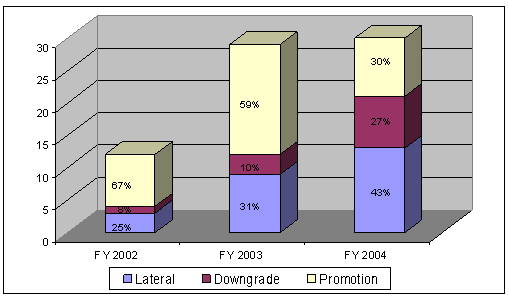
| Source: The FBI |
For FYs 2002 - 2004, of the 244 employees who transferred from another job within the FBI to an analyst position, 54 percent were assigned to headquarters, 41 percent were assigned to field offices, and 5 percent were assigned to other FBI offices. Employees assigned to headquarters were also more likely to receive promotions as a result of the transfer. Forty-one percent of the headquarters employees who transferred into the analyst position received promotions, while 36 percent of the transfers in the field offices received promotions.
The FBI Needs More Intelligence Analysts
A number of FBI reports and planning documents address the need for the FBI to expand its analytical corps. According to its latest strategic plan, the FBI cannot implement an enterprise-wide intelligence capability without an appropriately sized intelligence workforce. The FBI recognizes that an enterprise-wide intelligence capability is necessary to meet current and emerging national security and criminal threats.
The Office of Intelligence clearly recognizes that the FBI needs to plan for the future of the FBI’s intelligence program. The Human Talent CONOPS created by the Office of Intelligence in September 2003 notes that the FBI’s analytical needs have increased dramatically and that approximately 17 percent of the FBI’s current intelligence analysts will be eligible to retire in the next 5 years. According to the CONOPS:
These two factors mean that a large number of analysts will be hired in a very short period. Therefore, effective recruiting, hiring, training, and workforce development plans are more of a necessity than ever before, and are critical to the future analytical program at the FBI.
In our September 2002 report on the management of the FBI’s counterterrorism program, we noted the need for the FBI to add professional intelligence staff to help meet a clear need for improving its ability to collect, analyze, and disseminate threat information.31 At that time, some FBI managers had described to us the FBI’s analytical capability as “broken.” Others on terrorism-related commissions and in Congress suggested that the FBI’s intelligence capability was virtually nonexistent.
Specifically, the FBI had difficulty pulling information together from a variety of sources, analyzing the information, and disseminating it. In other words, the FBI lacked the ability to “connect the dots” or establish relationships among diverse information. Moreover, the FBI lacked the capability to prepare a strategic or “big picture” intelligence estimate or threat assessment. Our report concluded that the FBI lacked a professional corps of intelligence analysts with a defined career path, standards for training or experience, or a system for effectively deploying and utilizing analysts to assess priority threats at either the tactical (investigative or operational) level or the strategic (long-term or predictive) level.
Similarly, the 9/11 Commission found that prior to the September 11 terrorist attacks, the FBI did not have a sufficient analytical capability. In discussing the formation of the now-defunct FBI Investigative Services Division, the 9/11 Commission noted that the plan for that division had “envisioned the creation of a professional intelligence cadre of experienced and trained agents and analysts.” However, the 9/11 Commission found that the plan for the analytical cadre failed because the FBI did not devote the necessary human resources. The FBI disagrees with the 9/11 Commission’s conclusion because the FBI said it did not have the authority to devote additional analysts to the new cadre. The FBI requested additional analysts, but its requests were rejected by the Department of Justice. However, given this background, the Office of Intelligence recognizes that hiring well-qualified analysts is a major priority.
The Office of Intelligence and the FBI’s Personnel Resources Unit share responsibility for recruiting analysts. According to the Office of Intelligence, recruiting has not been an impediment to hiring. In fact, one Office of Intelligence official said the FBI has been “swamped” with applicants, and both FBI managers and Office of Intelligence officials reported that the quality of analyst applicants has been high. One FBI manager who formerly worked for another intelligence agency said the quality of applicants was similar to what he had experienced at his former agency.
These results may be due in part to several recruiting initiatives instituted by the FBI to ensure that its future analytical corps possesses the critical skills needed to develop and maintain the FBI’s intelligence capabilities:
- National Recruitment Team. Thirty current intelligence analysts volunteered to recruit at colleges and job fairs.
- National Advertising Program. Between February and March 2004, the Office of Intelligence issued several press releases announcing the FBI’s hiring goals for the calendar year.
- Military and Law Enforcement Recruitment. FBI personnel attended a recruiting event aimed at former military. The FBI has not had trouble attracting enough former military to apply for intelligence analyst positions.
Also, the Office of Intelligence planned to pilot a college-level co-op program at the end of calendar year 2005.
Through our interviews of FBI analysts and managers, we identified several impediments that have prevented the FBI from meeting its de facto hiring goal. Among the factors we identified are attrition, the hiring process, Title 5 position classification rules, intelligence analyst career paths, and the large proportion of applicants who are offered positions pending background investigations who do not become FBI employees.
As stated previously, in FYs 2002 – 2004, 291 employees left the analyst position for other positions in the FBI or left the FBI entirely. Attrition among the FBI’s analysts is discussed in greater detail in Finding 5 of this report.
Several FBI managers told us the primary impediment to hiring intelligence analysts is the hiring process itself. In particular, the FBI has generally received a very good response to its job announcements. One FBI manager told us that one job announcement for 56 analysts resulted in approximately 2,000 applications. Every application had to be evaluated to determine whether the applicant met minimum qualifications.32 Those applicants who were judged minimally qualified had their applications passed to the FBI unit conducting the hiring. That unit formed a career board to conduct interviews and determine the best qualified applicants. The hiring manager then selected applicants from those rated best qualified. Many managers described this process of winnowing a large pool of applicants down to the best qualified as very time consuming and labor intensive.
The FBI has recently streamlined its hiring process. In May 2004, the FBI began using a commercially available automated application system to screen applicants for analyst vacancies. With the automated system, the FBI posts job announcements on the Internet and applicants can apply on-line. Each announcement is open for two weeks. After one job announcement ends, another opens immediately. Applicants not accepted under one job posting must reapply to be considered again. The basic steps of the automated process are outlined below.
- Applicants answer screening questions about their background such as their use of illegal drugs. If an applicant answers inappropriately, such as admitting to using hard drugs more than a certain number of times, the application process stops and the applicant is told that they are not qualified.
- Applicants have the option to submit a resume highlighting their qualifications and experience.
- Applicants are asked to answer a series of multiple choice screening questions. Depending on the grade for which the applicant is applying, the applicant also has to include a narrative to support his or her answer to some of the multiple-choice questions. Because the screening questions are weighted, not all questions have the same value.
- The FBI downloads and scores applications each workday. The applications with passing scores are sent to the division or field office that is the stated preference of the applicant.
- If the division or field office views the applicant favorably, a conditional offer of employment can be made.
Applicants who receive conditional offers of employment are placed in “background.” While in background status, applicants’ backgrounds are investigated to determine whether they are suitable for FBI employment.33 The investigation includes a drug test, a polygraph, and an extensive investigation into each applicant’s credit history, drug use, personality, and legal violations.
The table below shows, by month, the number of applicants entered into background during FY 2004. Shortly after the FBI started using the automated system to screen applicants in May 2004, that number rose dramatically. Part of the increase is the result of the FBI’s decision to issue conditional offers of employment to all applicants who receive a passing score on the automated system. We attribute the increase in the number of background investigations during May and June 2004 to the FBI’s adoption of the automated system.
Background Investigations Initiated
on Intelligence Analyst Applicants During FY 200434

| Source: The FBI |
Many background investigations are discontinued before completion. In FYs 2002 and 2003, the FBI initiated a total of 433 background investigations on potential intelligence analysts, and during that same time, the FBI discontinued 210 background investigations.35 The reasons for halting a background investigation vary. For FYs 2002 - 2004, a frequently cited reason for discontinuing a background investigation was that the applicant was no longer interested in the position. FBI managers we interviewed said that applicants often lose patience with the FBI’s hiring process and accept other jobs. Some applicants cannot financially afford to wait to be hired by the FBI, take other jobs, and are reluctant to leave jobs they have just begun. However, between FYs 2002 - 2004, 58 percent of discontinued background checks occurred for substantive reasons identified in the course of the background check. Among these substantive reasons were failing the polygraph examination and use of illegal drugs. The most frequently cited reasons for discontinuing background investigations on analyst applicants from FY 2002 – FY 2004 are listed in the table below.
Reasons for Discontinuing Background Investigations
FYs 2002 - 2004
| Reason for Discontinuation | FY 2002 | FY 2003 | FY 200436 | Total |
|---|---|---|---|---|
| No Longer Interested | 25 | 31 | 27 | 83 |
| Pre-employment Polygraph/Deception | 31 | 18 | 25 | 74 |
| Better Candidates Available | 27 | 2 | 0 | 29 |
| Admitted Drug Use | 9 | 5 | 13 | 27 |
| Presently Not Available | 1 | 1 | 12 | 14 |
| Pre-employment Second Polygraph/Deception | 0 | 6 | 6 | 12 |
| Credit | 1 | 4 | 6 | 11 |
| Pre-employment Second Polygraph Request Denied | 0 | 6 | 5 | 11 |
| Employment | 3 | 5 | 3 | 11 |
| Pre-employment Polygraph/ Drug Use/Lack of Candor | 3 | 3 | 2 | 8 |
| Other Discontinuation Categories | 8 | 21 | 21 | 50 |
| Total | 108 | 102 | 120 | 330 |
| Source: The FBI |
Even analysts who passed the background investigation found the process difficult. Some of the analysts we interviewed cited the following problems or complications with their own hiring:
- all of the supporting documentation for the security clearance was lost,
- the employment application was lost,
- there was no continuous point of contact at the FBI, and
- extensive travel outside the United States complicated the clearance process.
Another impediment to hiring large numbers of well-qualified analysts cited by FBI managers has been the requirement that the FBI comply with Title 5 of the U.S. Code. Title 5 contains employment provisions that govern most of the federal workforce, including position classification and grading. For example, Title 5 has prevented the FBI from offering a non-supervisory GS-15 position to any of its analysts. Other intelligence agencies are exempt from Title 5. FBI managers said the FBI competes with the other intelligence community agencies for the same pool of applicants, and those agencies with the Title 5 exemption have a competitive advantage because they can offer prospective employees a higher-graded career path.
According to the EAD for Intelligence and other FBI managers with whom we spoke, compliance with Title 5 prevented the FBI from developing an intelligence capability on par with the rest of the United States Intelligence Community.37 Further, these managers believe that compliance with Title 5 would prevent the FBI from being able to hire a sufficient number of intelligence analysts or retain analysts once it hires them. According to the FBI’s Strategic Human Capital Plan, the FBI needs “greater latitude to pursue innovative hiring, workforce management and performance enhancement initiatives to address its human resource management needs.”
For example, with the exemption from Title 5, the FBI could have non-supervisory analysts at the GS-15 and the Senior Executive Service (SES) pay levels. FBI managers we interviewed also believe that the ability to promote intelligence analysts to these senior levels may contribute to the hiring and retention of qualified individuals.
The new Consolidated Appropriations Act, 2005 and the Intelligence Reform and Terrorism Prevention Act of 2004, both of which were enacted in December 2004, collectively grant the FBI Director a waiver from portions of Title 5. These exemptions give the FBI flexibility to establish analyst positions, determine rates of pay for those positions, hire specialized personnel critical to the FBI’s intelligence mission at Executive Schedule I salary, and pay retention and relocation bonuses to critical intelligence personnel. The FBI believes that this flexibility should alleviate many of the concerns over Title 5 expressed by FBI managers and will aid the FBI in recruiting and retaining highly qualified intelligence analysts. The FBI is currently engaged in an extensive planning effort to implement the provisions of these new laws and improve the overall management of its intelligence program. The EAD for Intelligence said the FBI has begun a 20-position pilot project of its new authority to hire senior critical personnel. She said some of the new specialists would be assigned to the College of Analytical Studies.
The flexibilities discussed above are closely linked to the issue of retention of intelligence analysts. We address this issue in great detail in Finding 5 of this report.
The FBI has made significant progress in hiring qualified analysts over the last three years to help build its analytical corps. However, the FBI fell significantly short of its FY 2004 hiring goal. As a result, the FBI ended FY 2004 with an intelligence analyst vacancy rate of 32 percent. Also, new analysts who transferred from other positions within the FBI are less than half as likely to have an advanced degree and were less likely to have the desired military intelligence experience, intelligence community experience, be a Presidential Management Fellow, lived outside the United States, or have foreign language skills. The 9/11 Commission concluded that the FBI had promoted poorly-qualified administrative personnel to analyst positions, in part as a reward for good performance in other positions. Because one of the Office of Intelligence’s objectives is to enhance the status of the FBI’s analysts, the FBI should continue its efforts to hire the highest quality analysts possible. In terms of education and experience, the analysts who entered on duty in the last three years have — as a group — superior qualifications. We believe the FBI should select the best qualified personnel available such as these recently hired external candidates.
The FBI’s FY 2004 analyst hiring goal was based on the number of additional analyst positions the FBI received in its FY 2004 budget. We found no evidence that the FBI incorporated attrition projections, hiring capacity, training capacity, or other factors when it developed its hiring goal. Because the hiring goal did not consider these types of data, we are not able to conclude whether the hiring goal was a reasonable one.
We recommend that the FBI:
- establish hiring goals for intelligence analysts based on: a) the forecasted need for intelligence analysts; b) projected attrition in the analyst corps; and c) the FBI’s ability to hire, train, and utilize intelligence analysts; and
- assign applicants a point of contact at the FBI to answer questions during the application and background investigation processes.
Finding 2: Requirements and Staffing
- As of June 2004, 49 percent of the FBI’s 1,272 intelligence analysts were assigned to field offices, 42 percent to the four operational divisions at headquarters — such as the Counterterrorism Division — and 9 percent to other FBI entities. For years prior to FY 2005, the FBI did not establish the total number of analyst positions available to the FBI as a whole in a given year. In government, this number of positions is known as the Funded Staffing Level (FSL). Because the FBI had not established an FSL for intelligence analysts, it could not identify or track the number of analyst vacancies. However, after the completion of our field work, the FBI developed an FSL for intelligence analysts for use with its FY 2005 budget. Still, the FBI has not determined the total number of intelligence analysts needed to support its intelligence program. We believe that a formal requirements determination is necessary to properly size and allocate the FBI’s analytical corps. Further, a rationally based requirements determination would help support the FBI’s budget requests, recruiting and hiring plans, and any necessary reallocation of analysts. After we completed our audit, the Office of Intelligence began work on a formal requirements determination, but it has not yet completed an estimate of the number of analysts the FBI needs nor has it finalized the methodology for doing so.
Current Allocation of Intelligence Analysts
As of June 2004, 49 percent of the FBI’s intelligence analysts were assigned to field offices, 42 percent to operational divisions at FBI headquarters, and 9 percent to other FBI entities such as the Information Technology Centers, the Office of Intelligence, and the Critical Incident Response Group at Quantico, Virginia. Within the field offices, the number of analysts varied from 1 (Springfield, IL) to 59 (New York, NY). In terms of intelligence analysts, the five largest field offices were Los Angeles, Newark, New York, San Francisco and Washington. Each of these field offices had 25 or more intelligence analysts.
Allocation of FBI Intelligence Analysts
June 2004
| Organizational Unit | Number | Percent of Total |
|---|---|---|
| Field Offices | 612 | 49 |
| Headquarters – Operational Divisions | 523 | 42 |
| Other FBI Entities | 112 | 9 |
| Total | 1,247 | 100 |
| Source: The FBI |
As shown below, there is a significant disparity in the allocation of special agents and intelligence analysts to the FBI’s different organizational units. While less than half of the intelligence analysts were assigned to the FBI’s field offices, 86 percent of the special agents where assigned to the field. On the other hand, intelligence analysts were much more likely to be assigned to the operational divisions — such as the Counterterrorism Division — at headquarters than agents: 42 percent of the intelligence analysts and 6 percent of the special agents were assigned to the operational divisions at headquarters. Other headquarters units, and other FBI entities, such as the Critical Incident Response Group, received 9 percent of both the intelligence analysts and the special agents. The EAD for Intelligence told us she believes “[a]ll the intelligence is in the field,” and she is concerned that there are too few seasoned intelligence analysts working at the FBI’s field offices. In our judgment, the disparity in the allocation of intelligence analysts and special agents to the FBI’s field offices reinforces this concern.
Allocation of FBI Intelligence Analysts
and Special Agents, June 2004
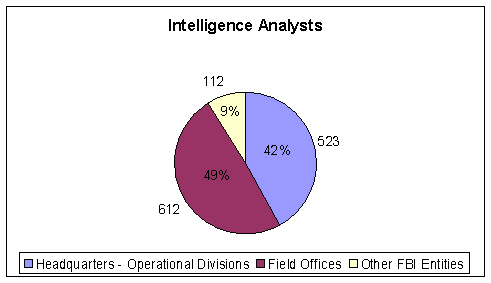
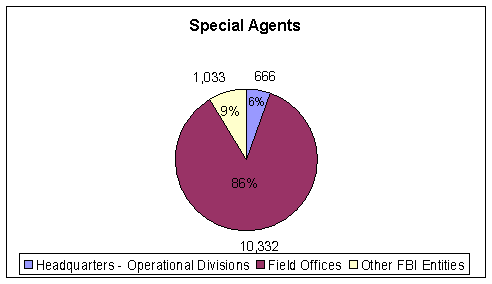
| Source: The FBI |
The distribution of analysts by GS pay grade varied widely by organizational unit. Analysts assigned to FBI headquarters operational units were most likely to be GS-14s. Fifty-seven percent of headquarters analysts were GS-13s and above. In the Counterintelligence Division, 54 percent of intelligence analysts were GS-14s and higher.
In contrast, analysts assigned to the field offices were most likely to be GS-11s. Sixty-eight percent of analysts assigned to the field were GS-11s and below. Only 8 percent of field office analysts were GS-13s and higher. Only the following field offices had GS-14 intelligence analysts: Denver, Indianapolis, Louisville, Pittsburgh, Richmond, Sacramento, San Diego, and San Juan. None of the five field offices with the most intelligence analysts had any GS-14s.
GS Level of Intelligence Analysts by
Organizational Unit38
| Organizational Unit | GS- 7 | GS- 9 | GS-11 | GS-12 | GS-13 | GS-14 | GS-15 | Executive Service |
|---|---|---|---|---|---|---|---|---|
| Field Offices | 2% | 9% | 56% | 24% | 7% | 1% | 0% | 0% |
| Headquarters (Operational Divisions) | 4% | 12% | 14% | 13% | 19% | 33% | 4% | 1% |
| Other FBI Entities | 2% | 6% | 49% | 12% | 13% | 16% | 2% | 1% |
| Total | 3% | 10% | 38% | 19% | 12% | 16% | 2% | 0% |
| Source: The FBI |
No Funded Staffing Level for Intelligence Analysts in FY 2004
As of September 2004, the FBI did not establish the total number of intelligence analyst positions available to the FBI as a whole in a given year. Because the FBI had not established a Funded Staffing Level (FSL) for analysts, it was unable to determine the number of intelligence analyst vacancies or the distribution of those vacancies across FBI units. According to the GAO, agencies should collect this type of data to evaluate the success of their human capital approaches, including strategies for attracting and retaining personnel.39 Subsequent to our audit field work, the FBI told us that it had established an FSL for intelligence analysts to be used during FY 2005. However, we did not evaluate the formulation of this FSL.
From FY 1996 through FY 2004, the FBI’s process for allocating positions did not specifically identify the number of analyst positions.40 This lack of an FSL for intelligence analysts was a result of the FBI’s budget process, which included FSLs for only two categories of employees, special agents and support staff. The support staff category included positions as diverse as clerk, intelligence analyst, forensic scientist, and attorney. Historically, FBI headquarters units and field offices have had wide flexibility in deciding the makeup of their support staff. Thus, if an intelligence analyst in a field office resigned, the special agent in charge had the latitude to replace the intelligence analyst with a financial analyst or some other category of support staff.
From FY 1996 through FY 2004, the FBI’s budget allocation process began when the President signed the budget. With the exception of earmarks, the FBI had discretion in how it apportioned its resources, including analysts. The budget broke support staff into the following classifications: clerical and administrative, investigative (includes intelligence analysts), and technical. Since FY 1996, the FBI has determined the three categories of support staff in the following manner:
- In general, .67 support positions are budgeted for every agent position according to the following formulas:
- the number of clerical positions is equal to .313 multiplied by the total number of agent and investigative support positions,
- the number of investigative support positions is equal to .246 multiplied by the number of agent positions, and
- the number of technical support positions is equal to .018 multiplied by the total number of agent, clerical support, and investigative support positions.
The budgeting process outlined above produced an FSL for investigative support staff, but not one for intelligence analysts. The number of intelligence analyst positions was ultimately determined by FBI units and field offices, with each unit or field office using its own methodology. After the FBI received its budget, the Resource Management and Allocation office (RMA) allocated the resources outlined in the budget. Following an informal and undocumented process, the RMA asked program managers, usually unit chiefs, to assess their current staffing levels and any additional needs. The program managers submitted their assessments and a proposed staffing level to their managers. The proposed staffing levels continued through the management chain until each division submitted a proposed divisional staffing level. Using the staffing data provided by the divisions, the RMA summarized the numbers submitted by the divisions and determined the appropriate staffing level for each division. However, the RMA’s determinations were not final. Ultimately, the level of personnel allocated to each division, section, unit, and field office was negotiated.
Once the RMA determined the FSLs, the individual sections and units had discretion in how they allocated personnel. For example, financial analysts, intelligence analysts, and investigative analysts are all part of the investigative subcategory of support personnel. If a unit received 100 positions in this subcategory, it could devote all 100 positions to financial analysts. The field offices, in particular, enjoyed the discretion to decide how to “spend” their FSL. Because the units and field offices valued the discretion to spend their FSLs according to their needs, the FBI did not institute an FSL for intelligence analysts prior to FY 2005. In addition, the FBI did not have the necessary information systems to track the positions throughout the FBI. Without an information system to track positions throughout the FBI, an FSL for intelligence analysts would have had little impact because FBI management would not be able to track vacancies and other hiring data.
Because the FBI did not have an FSL for intelligence analysts it was unable to provide its management, Congress, or other interested parties with data on the number of intelligence analyst vacancies. Information on the number of vacancies would have been useful in determining whether the FBI’s recruiting strategies were working as intended. Vacancy data also would have been helpful in targeting recruiting toward understaffed offices. In addition, an FSL for intelligence analysts would have elevated the visibility of the analyst position and underscored the important role of analysts in achieving the FBI’s mission.
In its FY 2004 budget, the FBI received an enhancement of 787 intelligence analyst positions.41 In the absence of an FSL for intelligence analysts for the organization as a whole and for each headquarters division and field office, the FBI allocated the positions provided in the FY 2004 budget using the following process. The RMA notified each program manager of the enhancement. Taking into account the total enhancement in intelligence analyst positions, each program manager requested the number of intelligence analysts desired. The RMA allocated the analyst positions to the program manager, who in turn allocated some of the positions to field offices. Each program manager had complete discretion in deciding the number of analysts to allocate to field offices and to which field offices to allocate them.
The process resulted in 384 of the new positions being allocated to the field offices, 401 to the 4 operational divisions at headquarters, and 2 to the Critical Incident Response Group. The 4 operational divisions received increases ranging from 7 to 277. The 56 field office increases varied from 3 to 26 positions. Four offices — Albany, Knoxville, Louisville, and Minneapolis — received increases of three positions each. The New York and the Washington field offices received the largest increase, 26 positions each. The other top increases went to Los Angeles (20 positions), San Francisco (14 positions), Chicago (12 positions) and Newark (12 positions). The table below shows the number of additional analyst positions each field office received in FY 2004.
Allocation of FY 2004 Enhancements in
Intelligence Analyst Positions, by Field Office
| Field Office | Additional Positions | Field Office | Additional Positions |
|---|---|---|---|
| Albany | 3 | Memphis | 5 |
| Albuquerque | 4 | Miami | 9 |
| Anchorage | 4 | Milwaukee | 4 |
| Atlanta | 10 | Minneapolis | 5 |
| Baltimore | 10 | Mobile | 3 |
| Birmingham | 5 | Newark | 12 |
| Boston | 11 | New Haven | 4 |
| Buffalo | 4 | New Orleans | 7 |
| Charlotte | 7 | New York City | 26 |
| Chicago | 12 | Norfolk | 4 |
| Cincinnati | 6 | Oklahoma City | 5 |
| Cleveland | 4 | Omaha | 4 |
| Columbia | 4 | Philadelphia | 9 |
| Dallas | 7 | Phoenix | 9 |
| Denver | 6 | Pittsburgh | 6 |
| Detroit | 10 | Portland | 4 |
| El Paso | 4 | Richmond | 4 |
| Honolulu | 4 | Sacramento | 5 |
| Houston | 7 | St. Louis | 4 |
| Indianapolis | 6 | Salt Lake City | 4 |
| Jackson | 5 | San Antonio | 6 |
| Jacksonville | 5 | San Diego | 5 |
| Kansas City | 5 | San Francisco | 14 |
| Knoxville | 3 | San Juan | 4 |
| Las Vegas | 5 | Seattle | 6 |
| Little Rock | 5 | Springfield | 4 |
| Los Angeles | 20 | Tampa | 7 |
| Louisville | 3 | Washington Field Office | 26 |
| Source: The FBI |
Allocation of FY 2004 Enhancements
in Intelligence Analyst Positions
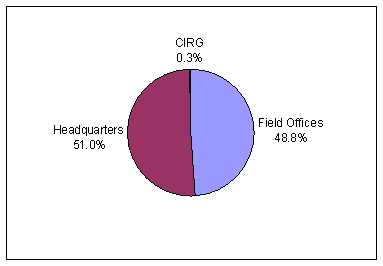
| Source: The FBI |
Funded Staffing Level Developed for FY 2005
In September 2004, after the end of our audit field work, the FBI developed an FSL of 2,062 for intelligence analyst positions and a base allocation of those positions by division and field office. The base allocation of those positions will first be used in conjunction with the FY 2005 budget. Both the FSL and the base allocation are predicated on the FBI’s 2004 funding levels. Any enhancements received in the FBI’s FY 2005 budget will be added to the base and allocated separately. The base allocation does not represent the total number of analysts needed by the FBI. Instead, the base allocation allocates the number of analyst positions available as a whole to divisions and field offices. To make this allocation, the RMA gathered and examined the following data:
- the number of analyst positions each field office had in FYs 2003 and 2004 (because there has never been an official FSL for intelligence analysts, the data reported by the field offices reflected the managerial decisions made by each field office),
- the number of intelligence analyst positions each division had in FYs 2003 and 2004 (because there has never been an official FSL for analysts, the data reported by the divisions reflected the managerial decisions made by each division),
- intelligence analysts on board by division and field office,
- enhancements in the number of intelligence analysts in the FY 2003 and FY 2004 budgets,
- allocation of special agents by program, and
- Time Utilization Record Keeping data for FY 2001 prior to the terrorist attacks of September 11, 2001, and for the first three-quarters of FY 2004.
In addition to reviewing this data and making the allocations, the RMA also consulted with the Office of Intelligence and obtained that office’s views on the current allocation of intelligence analysts.
Forecasting the Need for Intelligence Analysts
At the time of our audit, the FBI had not determined the total number of analysts it needed to support its intelligence program, nor did it have a methodology in place for doing so. To determine the correct size and allocation of the analytical corps to support the FBI’s intelligence program, the FBI should have a forecasting methodology based on assessments of both current and future threats and on overall intelligence collection, analysis, and dissemination requirements. The methodology should also determine the resource requirements across the FBI, including the operational divisions, field offices, and other offices.
According to the OPM’s Human Capital Assessment and Accountability Framework, an agency should have an explicit workforce planning strategy that is linked to the agency's strategic and program planning efforts. In addition, the workforce planning strategy should identify the agency’s current and future human capital needs, including the size of the workforce, its deployment across the organization, and the competencies needed for the agency to fulfill its mission.
To demonstrate that the size and allocation of the workforce is based on mission needs, the OPM states an agency needs to complete a number of planning steps. The following items summarize the most relevant steps.
- Develop a systematic process for identifying the human capital required to meet organizational goals and to develop strategies to meet these requirements.
- Develop a strategic workforce planning model for managers to assess and analyze their workforce. This model should describe agency-specific processes for setting strategic direction, restructuring the workforce through work-flow analysis to meet future needs, developing and implementing action plans, and evaluating and revising them as necessary.
Once an organization identifies its workforce gaps, it needs to develop a strategy to fill the gaps. The strategy should be tailored to address gaps in the number, deployment, and alignment of human capital. The correct number, deployment and alignment of human capital should allow an agency to sustain the contribution of its critical skills and competencies. The OPM suggests that each agency publish a strategic workforce plan that includes mission-critical positions, current needs, projected business growth, future needs by competency and number, and a basic plan to close the gaps identified.
The FBI’s EAD for Intelligence acknowledged to the OIG the need to tie the FBI’s allocation of intelligence analysts to existing and forecasted threats. In 2004, the Office of Intelligence published a Concept of Operations for Threat Forecasting and Operational Requirements (Threat Forecasting CONOPS). According to the Threat Forecasting CONOPS, the FBI will establish a Human Talent Requirements Forecast. The forecast will be an assessment of the characteristics of the personnel required to support the FBI’s intelligence program in the future. The annual forecast will be based on the Future Threat Forecast and an Operational Impact Assessment.42 As of September 2004, the Office of Intelligence had not implemented the Human Talent Requirements Forecast. However, the FBI told us that it is currently developing threat-based criteria for determining the total number of intelligence analysts needed by the FBI to meet its intelligence mission. This forecast, which will be a part of the larger Human Talent Requirements Forecast, will be used to support the FBI’s FY 2007 budget. The same threat-based criteria will also determine the allocation of intelligence analysts among the FBI’s divisions and field offices. The Office of Intelligence’s expectations for the larger forecast are described below.
The primary goal of the Human Talent Requirements Forecast is to estimate the overall level of analytical resources the FBI requires. The secondary goal of the forecast is to estimate the analytical resources required for specific job functions. In addressing these goals, the forecast will provide an estimate of the intelligence workforce capabilities that the FBI will require to adequately address all current and emerging threats. In addition, it will allow the FBI’s intelligence program to appropriately develop plans for recruiting, hiring, training, developing, and retaining intelligence personnel. The forecast will include all FBI employees that perform an intelligence analysis function.
According to the Threat Forecasting CONOPS, the Human Talent Requirements Forecast was to include an estimate of the number and characteristics of employees that the FBI will require in each intelligence job function, in each out-year, and in each threat issue area. The result will be an understanding of the overall level of analytic staff that the FBI must maintain, given that the analytic workforce will adapt and surge to address the changing threat environment. The Office of Intelligence will translate human staff needs into specific hiring and training plans.
The Threat Forecasting CONOPS establishes the guiding principles that will be applied to formulating human talent requirements for the intelligence function. According to the CONOPS, the following principles are critical to ensuring an enterprise-wide approach to building and executing the FBI intelligence program.
- Threat-Based: intelligence capabilities must be adequate for current and future threat environments.
- Linked to Resource Decisions: the Intelligence Human Talent Requirements Forecast will be used by the Intelligence Production Board to manage current, and allocate future, FBI analytical resources and to assess gaps in FBI capabilities.43
- Common Vocabulary: the intelligence program must ensure an enterprise-wide, common vocabulary for discussing, tracking, and assessing threat information.
- Dependencies: the human talent capabilities forecasting process relies on the ability of the Office of Intelligence to:
- adequately assess the threat implications for intelligence production, collection, analysis, and dissemination; and
- translate accurately threat implications into the number and type of intelligence analysts required to meet intelligence production requirements.
- Advocacy: the Office of Intelligence will articulate shortfalls in meeting the intelligence production requirements at current or projected funded staffing levels.
The Office of Intelligence has also taken other steps to further its efforts to develop an FBI-wide threat forecast that can be used to project the personnel needed for the FBI’s intelligence program. In April 2004, the Office of Intelligence sent an electronic communication (EC) to all four operational divisions, the Information Resources Division, and the Laboratory Division instructing program managers in those divisions to provide the following information:
- a complete and specific narrative description of the methodology used to allocate analyst positions provided in the budget process, including supporting charts, graphs, and other data depictions;
- a spreadsheet showing the current allocation of analyst positions. The spreadsheet was to show the distribution of analysts down to the unit level; and
- FY 2006 internal budget requests for intelligence analyst positions for headquarters and the field offices.
We do not believe that the methodology for determining the number of intelligence analysts needs to be complicated. However, the methodology needs to be supported by data and be consistent with the FBI’s strategic mission.
Although the Threat Forecasting CONOPS and the Office of Intelligence’s April 2004 EC demonstrate the need for a standard methodology for determining the number of intelligence analysts the FBI needs to carry out its mission, the Office of Intelligence has not completed such a methodology, nor has it completed a threat-based or risk-based methodology for allocating its current intelligence analyst positions. The Office of Intelligence is currently developing threat-based criteria to determine its mission needs and its internal allocation. We believe the FBI needs to implement both a threat-based method of determining the number of analysts it needs to carry out its mission and a threat-based method of allocating those analysts. Both of these requirements forecasts would help the FBI decide the appropriate size of its analytical corps as well as support budget requests, hiring plans, and any reallocation of analysts.
We recommend that the FBI:
- develop and implement a threat-based or risk-based methodology for determining the number of intelligence analysts required,
- develop and implement a threat-based or risk-based methodology for allocating intelligence analyst positions across the FBI’s headquarters divisions and field offices,
- link the methodology for allocating intelligence analyst positions to the Human Talent Requirements Forecast, and
- list the current FSL for intelligence analysts and any requested additions to this FSL in all budget documentation.
- The FBI’s Human Capital Plan calls for analyst training that is “second to none.” We found that progress toward achieving that goal has been slow but is improving. The FBI has taken the initial steps needed to create an introductory intelligence analyst course that is aligned with the FBI’s strategic objectives. Shortly after the September 11 attacks, the FBI established the College of Analytical Studies (CAS) and assigned it responsibility for training new FBI analysts. However, we found that the 5-to-6 week Basic Intelligence Analyst (BIA) course at the CAS struggled to provide quality training to all new analysts. Classes for new analysts have not been full, and student evaluations of the basic course have been largely negative. Many analysts we surveyed said the class did not adequately prepare them to perform their jobs. In an attempt to address student concerns, the FBI modified the curriculum several times and, as a result, many analysts said the course appeared disorganized. The FBI has recognized many of the shortcomings in the course and implemented a revised 7-week course called the Analytical Cadre Educational Strategy 1 (ACES-1) in September 2004. We believe ACES-1 will be an improvement over the former basic course, although some problems may remain, such as ensuring attendance and the lack of sufficient FBI instructors.
The College of Analytical Studies
In response to the September 11 terrorist attacks, the FBI Director assigned the FBI’s Training and Development Division to immediately coordinate, develop, and implement a professional training program for analysts. In October 2001, the FBI formally established the CAS at the FBI Academy in Quantico, Virginia, with the following mission:
- conceptualize analytical training programs,
- identify analytical training resources, and
- administer the CAS with a focus on improving the FBI’s analytical capabilities to meet all the FBI’s present and future investigative responsibilities.
The first course established at the CAS was the BIA.44 The BIA course was first held in FY 2002 and was mandatory for all FBI intelligence analysts. Since its inception, the BIA has been a residential training program. The first session of the BIA was five weeks long. As a result of student feedback and changes in the curriculum, subsequent versions of the class have varied in length from five to six weeks.
The BIA has undergone several curriculum changes. The first four or five sessions of the BIA followed what one FBI manager called an “emergency curriculum.” With expediency a major factor, the CAS modeled this curriculum on the FBI’s new agent training. By not having to develop a curriculum from the start, the CAS was able to launch the BIA quickly. However, the CAS soon recognized that the new agent curriculum was not well-suited to training intelligence analysts. Based on the experience with this first curriculum, the CAS assembled a team of analysts from both headquarters and field offices to develop what it believed would be a more appropriate curriculum. However, the new curriculum was never implemented because the newly formed Office of Intelligence, which at that time was part of the Counterterrorism Division, did not approve the course.
Although the Office of Intelligence did not approve the revised curriculum, the effort formed the basis for the approved second version of the course, which included six weeks of instruction. As suggested by the Office of Intelligence, the second curriculum included two segments developed and taught by another intelligence agency. This portion of the class took two weeks and covered analytical thinking and writing. The remaining four weeks of the class were a condensed version of the new FBI curriculum. FBI managers said the new class did not flow well and was repetitive at times. They also said these problems were caused by simply inserting two weeks of outside instruction into the FBI curriculum rather than integrating the outside instruction.
By refining the second generation curriculum, the CAS developed a third generation curriculum for use during FY 2004. The course content was re-ordered and the repetition was eliminated.
All analysts, new hires and veterans alike, were required to attend the BIA. However, we found that 75 percent of the analysts who had not attended the course did not want to enroll in future sessions of the course, with the most frequently cited reason being that the BIA would repeat training the analysts had already taken elsewhere.
Reasons Analysts Do Not Want to
Attend the Basic Intelligence Analyst Class
| Response | Percent45 |
|---|---|
| The class will repeat topics of courses I’ve already attended. |
82 |
| I do not need to attend because of my years of analytical experience. |
60 |
| I have not heard positive feedback from those who have attended. |
44 |
| My supervisor is discouraging me from attending because I’ll be away from work for an extended period. |
3 |
| Other (Please specify) | 37 |
| Source: OIG survey of FBI intelligence analysts |
The reluctance to attend the BIA course is reflected in attendance statistics. While all analysts are required to attend the course, enrollment in any particular session is voluntary. As shown in the following charts, our review of FBI data found that there were vacancies in each fiscal year from 2002 - 2004 and that, in total, BIA classes for FYs 2002 - 2004 were only about 56 percent full. If these classes were full, the FBI could have trained an additional 240 intelligence analysts.
Basic Intelligence Analyst Class
Students Trained and Vacancies, FY 2002 - 200446
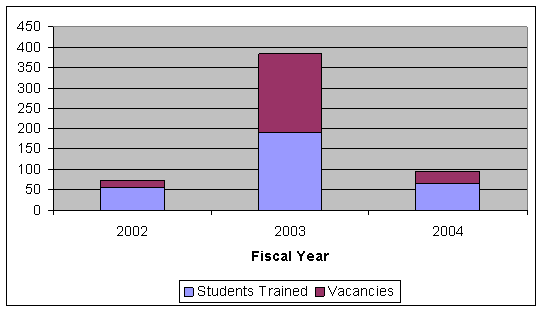
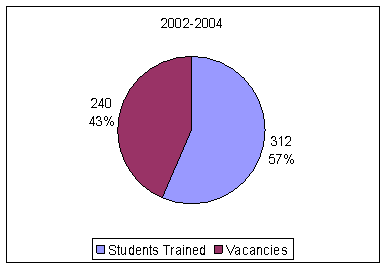
| Source: The FBI |
CAS officials acknowledged that BIA course attendance was low. According to these officials, the fact that analysts were not directed to attend a particular session of the BIA course caused a high number of vacancies. They believe that the intelligence analysts’ managers should have been held accountable for ensuring that all of the analysts under their supervision have attended the course. Specifically, they advocated having the analysts’ managers submit a plan to the Office of Intelligence showing when all of their intelligence analysts would attend the training.
Student Feedback on the BIA Course
Our interviews with analysts who have taken the BIA course, reviews of student evaluations, survey results, and our review of the curriculum, suggest that the course did not sufficiently prepare analysts to perform their jobs. Of the 186 respondents to our survey who attended the BIA course, over 60 percent said that the course did not meet their expectations for helping them do their work. Only 6 percent of the respondents said the BIA course exceeded or greatly exceeded their expectations.
Student Satisfaction With the
Basic Intelligence Analyst Class
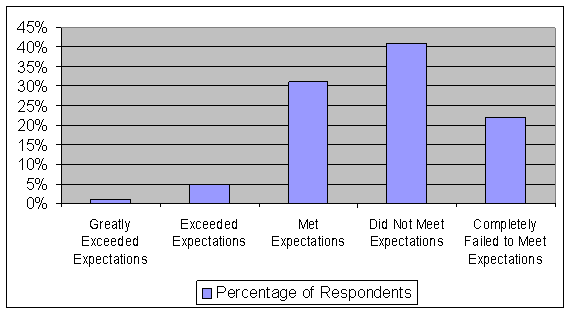
| Source: OIG survey of FBI intelligence analysts |
In addition to our survey, we reviewed student evaluations of the BIA course. We randomly selected and reviewed 32 of the 224 evaluations the FBI had on file and found that only 38 percent of the respondents in our sample believed that the BIA would help their performance. Further, only 47 percent of the respondents in our sample reported that they learned new information in the BIA course.
The evaluations are particularly noteworthy given that 72 percent of the respondents in our sample had less than one year experience as an analyst.
During our interviews of 17 analysts who had attended various versions of the BIA, they reported various reasons for their dissatisfaction:
- the course did not cover the specialized software used by FBI intelligence analysts,
- there were not enough FBI instructors,
- the information presented was too basic,
- the course was not well organized, and
- the course did not address the actual work done by intelligence analysts.
The analysts’ concerns about the organization of the class were widespread. These concerns were mirrored in the results of our review of the student evaluations. In our sample of the evaluations, only 19 percent of the respondents thought the class was well-organized.
During our interviews, analysts suggested ways to improve the BIA course. We included many of those suggestions into our survey and asked analysts who had attended the course to tell us which of the following suggestions they thought would improve it. We received the following survey responses.
Suggestions to Improve the
Basic Intelligence Analyst Class
| Response | Percent |
|---|---|
| Integrate software used by intelligence analysts into case studies | 87 |
| Spend more time on the tools FBI intelligence analysts use | 83 |
| Integrate case studies throughout the new analyst training | 79 |
| Integrate introductory analyst training with new agent training | 70 |
| Spend more time on preparing specific intelligence products | 70 |
| Breakout training according to role (all source, operations specialist, and reports officer) | 67 |
| Breakout training according to operational division | 52 |
| Other | 24 |
Source: OIG survey of FBI intelligence analysts
Analytical Cadre Educational Strategy 1 Course (ACES-1)
In 2004, the Office of Intelligence and a contractor have developed a new 7-week introductory level course for intelligence analysts, called Analytical Cadre Educational Strategy 1 (ACES-1). ACES-1 replaced the BIA in September 2004. Under the auspices of the Office of Intelligence, the FBI Academy will be responsible for course delivery. The primary objective of ACES-1 is to produce graduates having the skills and capabilities needed to perform any of the three work roles: all source intelligence analyst, operations specialist, and reports officer.
Initially, the students attending ACES-1 will be a mix of new intelligence analysts who are just entering on duty and those who are currently assigned within the FBI. The students who are entering on duty at the training will attend a 3-day “Introduction to the FBI” course immediately prior to attending ACES-1. After completing ACES-1, the new analysts will be assigned to a unit within the FBI. The Office of Intelligence’s goal is to have all new intelligence analysts start their employment at the FBI Academy. However, the Office of Intelligence predicts that it will take until the beginning of FY 2006 before the ACES-1 course is comprised entirely of analysts who are entering on duty. The capacity of each ACES-1 session will be 48 students.
Development
In evaluating the introductory analyst course and the needs of the FBI’s intelligence program as a whole, the Office of Intelligence developed seven core elements for FBI intelligence training. The ACES-1 class will be based on these elements. The seven elements are: 1) FBI intelligence mandates and authorities, 2) the intelligence cycle, 3) the United States Intelligence Community, 4) intelligence reporting and dissemination, 5) FBI intelligence requirements and the collection management process, 6) the role of the intelligence analyst, and 7) validating human sources.
The overall structure and instructional design of ACES-1 are built around the seven core elements for intelligence training. According to the Office of Intelligence, a variation of these core elements is well-accepted by the rest of the intelligence community. Office of Intelligence managers said that in developing ACES-1, the FBI did not want to “reinvent the wheel.” In addition to applying the generally accepted core elements in developing the curriculum, the FBI’s contractor consulted with other federal agencies, companies that provide training to intelligence analysts elsewhere, experienced FBI intelligence analysts, and academic institutions with intelligence programs. The contractor is also responsible for ensuring that the course material is presented in an appropriate sequence. Finally, the contractor is responsible for vetting the instructors who will present the material at ACES-1 classes.47
Curriculum Review
According to the course design, ACES-1 includes 35 days of instruction over 7 weeks, which comprises 74 instructional blocks. Included in that 35 days are 9 hours that are not instructional. Block 7 allows 1 hour for credential photos, and Block 74 allows 8 hours for graduation and out-processing.
The instructional design of the ACES-1 course is grouped into five components: 1) Foundations for FBI Intelligence Analysts, 2) FBI Intelligence Program, 3) Core Competencies of FBI Intelligence Analysts, 4) FBI Intelligence Analyst Field Skills, and 5) Practical Application Exercise and Graduation.
The Foundations for FBI Intelligence Analysts component lasts 5 days and includes 16 instructional blocks, which cover areas such as security classifications and clearances and developing a professional support network of analysts. The FBI Intelligence Program component lasts 5 days and includes 11 instructional blocks, which cover topics such as the FBI intelligence cycle and the role of the FBI intelligence analyst. The Core Competencies of FBI Intelligence Analysts component lasts 16.5 days and includes 34 instructional blocks, which address areas such as report writing, analytical methodologies, and analytical tradecraft. The FBI Intelligence Analyst Field Skills component lasts 6.5 days and includes 11 instructional blocks that vary from statement analysis to fraudulent financial transactions. The Practical Application Exercise and Graduation component lasts 2 days and includes 2 instructional blocks: an 8-hour exercise and 8 hours for graduation.
In our judgment, the newly-designed ACES-1 curriculum generally is a well-balanced introductory analyst course. However, we have three concerns: 1) the amount of time spent on some subjects; 2) the number, length, and type of class exercises; and 3) computer training.
Concerning the amount of time spent on some subjects, we looked at the amount of instruction provided on intelligence dissemination and intelligence assessment. In our survey of intelligence analysts, threat assessment was the area in which the most respondents said they needed additional training. According to the instructional plan we reviewed, ACES-1 devotes only four hours to this topic. In addition, the 9/11 Commission called the lack of information sharing the biggest impediment to all source intelligence analysis. The 9/11 Commission also stated that “Intelligence gathered about transnational terrorism should be processed, turned into reports, and distributed according to the same quality standards, whether it is collected in Pakistan or Texas.” ACES-1 provides only eight hours on intelligence dissemination. In addition, because the intelligence dissemination class is not held in a classroom equipped with computers, students cannot practice electronically disseminating FBI intelligence products electronically.
Concerning the number, length, and type of class exercises, analysts we interviewed and survey respondents told us that more exercises would be helpful. In reviewing the ACES-1 curriculum, we could not quantify the number of exercises or amount of time devoted to them. However, we did determine that 49 percent of the instructional blocks had some type of exercise or case study for a portion of the class. Also, an additional 15 percent of the instructional blocks used computer labs for software instruction. But not all of these exercises appear to be directly related to the work of an intelligence analyst. For example, two exercises are related to the Myers-Briggs personality test. While the computer training will be in a classroom equipped with computers, we were unable to determine whether the exercises will require analysts to develop FBI intelligence products. Because the computer-related classes will be held before students are introduced to FBI intelligence products, it seems unlikely that the computer exercises will require students to use computers in developing or disseminating intelligence products.
Our third concern, computer training, is related to the other two concerns mentioned above. ACES-1 will include what an FBI manager described as a limited amount of software training. As a result of the lack of computer-equipped Sensitive Compartmented Information Facilities (SCIFs) and secure classrooms, all of the software training at ACES-1 will be unclassified.48 At no point does ACES-1 address any of the highly-classified databases that many FBI intelligence analysts regularly use, such as Intelink and CT Link. According to CAS officials, the FBI recognizes this weakness and is building more SCIFs at the FBI Academy to correct it.
Commercially available software will be used in ACES-1, but students will use guest accounts for that training. Any data they enter into the systems will not be accessible at their workplaces. The Office of Intelligence would like to eventually make it possible for the students to obtain user accounts as part of the training and use the FBI computer network in their ACES-1 classrooms. If the students have user accounts, once they report to their assigned positions, the exercises and data would be available.
Finally, we noted that the FBI’s contractor will be responsible for evaluating the ACES-1 training. Initially, the evaluation will be informal and based on the observations of the contractor’s staff. Office of Intelligence officials told us that students will not be tested on subject matter learned because the analyst job announcements do not state that passing training is a condition of employment. According to the Office of Intelligence, specific evaluation plans for ACES-1 are still in their infancy because both the FBI and its contractor are primarily concerned with implementing the new curriculum.49
Instructor Review
One challenge the FBI faces in training its analysts is developing FBI employees to teach segments of the introductory intelligence analysis course. The FBI recognizes this shortcoming and plans to have FBI personnel “shadow” the contract instructors and managers. The plan is to have some of those FBI personnel become either adjunct faculty or class administrators. The CAS also wants to provide some full-time instructors for the critical intelligence elements taught in ACES-1.
The BIA course used many instructors who are either contractors or personnel from other agencies. During interviews with intelligence analysts who had attended the BIA course, we were often told that the students wanted to learn “the FBI way” of approaching different topics. The analysts did not think that instructors from other agencies provided them with that perspective. According to one instructor from another intelligence agency, developing instructors is a major challenge for the FBI that requires more attention.
The FBI plans to use a mix of instructors for ACES-1. The instructional design we reviewed showed that FBI personnel will be teaching 33 percent of the 280 class hours and 34 percent of the 74 instructional blocks. A mix of FBI instructors and non-FBI instructors will teach 5 percent of the instructional hours and 7 percent of the instructional blocks. Non-FBI personnel, including contractors and other government agency personnel, will teach 59 percent of the instructional hours and 57 percent of the instructional blocks.50
The amount of FBI-provided instruction varies by course component. The FBI Intelligence Analyst Field Skills component, for example, has the highest level of FBI instruction. FBI instructors are to teach 69 percent of the instructional hours and 55 percent of the instructional blocks for that component. The Core Competencies for FBI Intelligence Analysts component has the lowest level of FBI instruction. Instructors from outside of the FBI will teach 91 percent of both the instructional hours and instructional blocks.
Analyst Training at the CIA and DIA
In order to better evaluate the FBI’s introductory training for intelligence analysts, we interviewed officials at the Central Intelligence Agency (CIA) and the Defense Intelligence Agency (DIA) to learn how those agencies provide introductory analyst training. As described below, we found that the introductory training for intelligence analysts at the FBI, CIA, and DIA varies significantly in overall approach, length, and evaluation. The FBI and the CIA both have one extended class for introductory analysts that covers multiple topics the agency managers believe are necessary. The DIA, however, uses a “smorgasbord” approach to training and does not have a mandatory introductory analyst class. The FBI’s ACES-1 is 7 weeks long while the CIA’s introductory class is 16 weeks long. The CIA’s introductory class features testing throughout and individual DIA classes have tests. The FBI’s ACES-1 does not have tests.
CIA
The CIA’s Sherman Kent School is dedicated to training intelligence analysts and, to that extent, is similar to the FBI’s CAS. The Kent School consists of three parts: 1) the Career Analyst Program (CAP), 2) the Intelligence Analyst Training Program, and 3) the Kent Center. The CAP is the CIA’s new analyst training program. The Intelligence Analyst Training Program is the CIA’s “discipline-focused” program for experienced analysts, defined as those with five or more years of experience. In the Intelligence Analyst Training Program, experienced analysts receive mid-career training tailored to the areas or specialties in which they work. The Kent Center is the Kent School’s outreach arm. It disseminates examples of products, evaluates CIA intelligence products, and reaches out to the academic and private sectors.
The CAP is five years old. In that time, 31 classes have graduated. The CIA has experimented with the length of the CAP. It is currently 16 weeks long and the program director believes that is the appropriate length. In earlier iterations, the CAP was as long as 26 weeks. Prior to attending the CAP, all students attend “CIA 101,” where they fill out their national security forms and health forms and take care of other administrative tasks. Also prior to attending the CAP, they work in the units to which they are permanently assigned for two to five months. The CIA believes this work experience helps new analysts in three ways: 1) they gain exposure to the work of the CIA, 2) they get an opportunity to understand who their unit’s customers are, and 3) the time working in the units gives context to the training they receive in CAP.
The three-fold mission of the CAP is to educate its students: 1) about the history, mission, and values of the CIA with an emphasis on the Directorate of Intelligence; 2) on analytical tradecraft, and 3) about the United States Intelligence Community. The CIA officials we spoke to, believe that the accomplishment of these three missions leads to the CAP’s ultimate objective: after completing CAP, all students return to their positions with the professional knowledge they need to perform their jobs.
The history, mission, and values portion of the CAP includes sections on lessons learned, the Directorate of Intelligence customer focus, ethics, and analytical objectivity. The CIA believes that lessons learned provide valuable insights into the challenges the intelligence community faces today, so the CAP examines historical events including, the Battle of Gettysburg, the attack on Pearl Harbor, and the September 11 terrorist attacks. The CAP also attempts to instill in new analysts the CIA’s customer focus, and also how their analytical products influence the nation’s policy and law enforcement operations. The CAP includes a 2-day segment on the Directorate of Intelligence goal to be analytically objective in all its work.
The analytic tradecraft mission of the class is fulfilled by a 2-week analytical thinking section, a 3-week analytical writing section, a 1-week briefing section, and a 1-week teamwork section. The analytical thinking section introduces students to a variety of analytical tools and thinking methods, denial and deception practices, indications and warning, targeting analysis, and terrorism analysis. The 3-week writing section emphasizes the CIA’s deductive, journalistic writing style, with the main points stated first. Participants practice writing a variety of CIA products to which they are given feedback. The 1-week briefing section covers the types of briefings that CIA analysts provide. The 1-week teamwork section covers a variety of teamwork exercises including team building, the Myers-Briggs personality test, conflict resolution, and giving and receiving feedback. The CIA believes the teamwork section is essential to educating new analysts because almost all of the CIA’s products are collaborative efforts.
In the CAP there are three main “task force” exercises: simulations in which the students have to complete tasks and respond to incoming information within a limited amount of time. These task force exercises range in length from one to two-and-a-half days. The third task force is a continuous 30-hour exercise where the students respond to information and tasks at all times of the day and night. During this exercise, students brief CIA officials who role play as senior government officials, write Presidential Daily Briefs, and evaluate cable traffic and other data. In the task force exercises, senior CIA analysts role play senior CIA and government officials. To make the exercises as realistic as possible, the analysts acting as the senior government officials attempt to exhaust the students and create pressure similar to what they would experience in a real situation. The exercises are designed to be very demanding, so the students can better understand their current strengths and weaknesses. The final exercise is a terrorism simulation where the students must determine who attacked the United States.
Students spend 5 of the 16 weeks at a rotation outside of their home office. The rotation may be in another CIA office, another federal agency, or some entity outside the government. In conjunction with the student, the student’s home office decides where the student will go on rotation and makes all of the arrangements. Involving the student’s home office in selecting the rotation attempts to ensure that the rotation will be beneficial to the student’s performance once the student returns to his or her job.
Students at the CAP are constantly evaluated and coached. For example, they receive feedback on all of their written assignments. In addition, after the six weeks of class immediately prior to the “rotation,” they take a midterm exam. The final exam is a 30-hour role-playing exercise.
All of the CAP’s permanent staff are GS-14 or GS-15 professional analysts assigned to the Kent School on a 2-year rotation, with an optional third year. The permanent staff manage and instruct the CAP and other Kent School programs. In addition, the Kent School uses part-time instructors. The part-time instructors are both contractors (usually retired CIA) and current CIA analysts. All instructors have to be certified by the CIA University. Certification requires attendance at a 1-week instructor class and an in-class evaluation of the instructor.
All classes are held in SCIFs. There are computer-equipped breakout rooms used to work on class assignments. The computers in the breakout rooms are connected to the CIA’s network and students have full access to all of the agency’s databases.
DIA
The DIA takes what it refers to as a “smorgasbord” approach to training. The DIA does not have a mandatory introductory analyst class. Instead, each analyst develops an Individual Development Plan (IDP) in consultation with his or her supervisor. These plans are tailored to the individual needs of the analyst, and state which courses the analyst will take during the period covered by the plan.
While the smorgasbord approach allows a wide degree of flexibility, DIA officials said most new analysts take three courses within their first year. The first course is the Basic Analyst course. This 2-week course covers intelligence analysis, analytical thinking, and research skills. Representatives of foreign governments often attend this class, so none of the material in the class is classified and it does not include any simulation exercises. The second course is Introduction to Intelligence Collections, which includes topics such as the limitations and capabilities of collections systems. The third course is a 3-day class entitled Analytic Writing, where students write intelligence products similar to those they would write on the job. Typically, students complete these three courses and then pursue specialty courses related to their particular job assignment. Students may take these specialty classes shortly after completing the three basic classes, or they may wait until the classes are more relevant to the work they are doing.
Most classes at the DIA include some type of test to determine whether the students have mastered the material in the class. The tests vary in type from written exams, practical exercises, and papers, to group exercises. All tests are graded pass/fail, but the grade is intended only for the benefit of the student and is not recorded by the DIA. However, students must pass all of the course examinations to receive credit for that course. If a student fails a test, the student may take the class again or negotiate with the instructor to determine how the student can demonstrate mastery of the subject. At the instructor’s prerogative, the student may be allowed to retake the test, participate in a group exercise in another session of the class, or retake portions of the class. If the instructor offers a student a second testing opportunity and the student fails a second time, the student must retake the entire course.
Observations on the FBI’s College of Analytical Studies
We spoke with one guest instructor at the CAS from another Intelligence Community agency. A seasoned intelligence professional, he pointed out the limited number of staff at the CAS compared to other intelligence community training facilities where the faculty is dedicated to the facility for given periods. The instructor said that in his opinion the FBI does not appreciate the importance of having a dedicated staff at the CAS. He cited his experience at the CAS, for example, during which time he was teaching under the train-the-trainer concept. The idea was that two FBI personnel would attend the sessions he taught and, after a number of sessions, would ultimately be able to teach the sessions themselves. However, this concept failed because the FBI personnel were always being called upon to perform other duties and were never able to attend the sessions in their entirety.
The same guest instructor stated that he believes that the FBI has grossly underestimated the investment in staff necessary to make the introductory analyst program work. For example, if the FBI is going to require students to write papers during its introductory analyst class, it needs sufficient staff to read the papers and provide individual feedback. He believes that because the FBI has not invested sufficient resources, it has to rely on contractors to teach most of the introductory analyst class.
Training is a key element in developing a well-qualified corps of FBI intelligence analysts. Without a first-rate training program, the FBI cannot fully develop its intelligence program. As the FBI’s Strategic Human Capital Plan notes:
Historically, the FBI has been an Agent centric organization because the core mission of the FBI has been performed by Special Agents. The Director elevated intelligence to program status and has made it a priority function within the FBI. As a result, the professional analyst, like the Special Agent, performs part of the core business of the FBI. Hence, the FBI must have a training and career development program for its analysts that is second to none.
Aside from the limitations the FBI faces in the CAS, such as the lack of secure classrooms and access to the FBI’s computer networks, the new ACES-1 curriculum seems generally sound and reasonable.
The success or failure of ACES-1 may well depend on two factors: providing qualified FBI instructors to the course and evaluating the quality and effectiveness of the training. The FBI must ensure that it dedicates a sufficient number of FBI employees as ACES-1 staff and that these employees take over instruction of the majority of the instructional blocks, including those addressing the Core Competencies of FBI Intelligence Analysts. The FBI also needs to thoroughly evaluate the ACES-1 curriculum after it is implemented and ensure that it meets the needs of new analysts as well their supervisors. Lastly, the FBI needs to ensure that all analysts who need training receive it.
We recommend that the FBI:
- ensure that all ACES-1 courses are full;
- develop a more rigorous training evaluation system that includes the effectiveness and relevance of each instructional block; asks analysts what other topics need to be covered; obtains the views of analysts after returning to work when they can evaluate the effectiveness of the training in improving their job skills; and obtains evaluations of training effectiveness from analysts’ supervisors;
- develop a methodology to determine the number of staff needed to teach ACES-1 and a plan to staff ACES-1 with FBI personnel, including experienced FBI intelligence analysts; and
- integrate testing into the ACES-1 curriculum.
Finding 4: Utilization of Intelligence Analysts
Based on our survey of FBI intelligence analysts, the vast majority reported that they: 1) believe they make a significant contribution to the mission of the FBI, 2) are satisfied with the work assignments they receive, and 3) are intellectually challenged by their work. However, smaller percentages of analysts, including some of the newer and more highly qualified analysts, are less satisfied with their work assignments than analysts as a whole. Some analysts reported that their contribution to the FBI’s mission is low and they do not feel intellectually challenged by their work.
Through our survey, we found that the type of work done by FBI intelligence analysts varies depending on location, years of employment, and education level. According to our survey, work requiring analytical skills accounts for only an average 50 percent of intelligence analysts’ time. During our interviews with analysts, we found that many are asked to perform administrative tasks that are not analytical in nature, such as escort duty.
We identified two primary reasons for analysts not being used for analytical purposes. First, several analysts told us that not all FBI special agents understand the capabilities or functions of intelligence analysts. Second, most analysts are supervised by special agents rather than higher-graded analysts. Many analysts with whom we spoke believe that analysts should be supervised by other, more senior, analysts. In our opinion, the FBI’s ability to develop and retain a well-qualified analytical corps depends on it fully utilizing the specialized skills of its analysts.
To determine how the FBI is utilizing the skills of its intelligence analysts, in our survey questions we asked about: 1) their level of contribution to the FBI mission; 2) their satisfaction with the work assignments intelligence analysts received; 3) the intellectual challenge of their work as an FBI analyst; and 4) the type of work analysts performed, including the products they produced. In addition, we interviewed 25 analysts to learn in greater detail about their work.
Contribution to the FBI Mission
The FBI’s analysts we surveyed as a whole believe that they are contributing significantly to the FBI’s mission. Seventy-three percent of the respondents to our survey rated their contribution to the FBI mission as “high” or “very high.” As shown below, only four percent of the respondents rated their contribution as “below average” or “low.”
Analysts’ Perceived Contribution to the FBI’s Mission
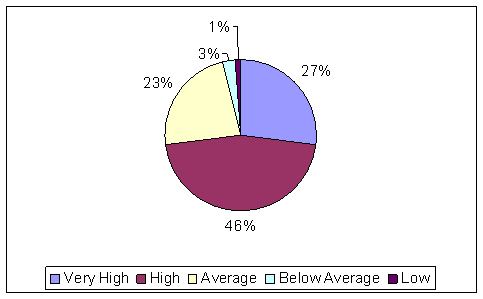
| Source: OIG survey of FBI intelligence analysts |
Yet, analysts in the following groups gave lower ratings on their level of contribution to the FBI mission than other analysts: 1) hired in the last three years, 2) military intelligence experience, 3) Presidential Management Fellows, 4) advanced degrees, 5) intelligence community experience, and 6) assigned to headquarters. As shown below, all of these groups of analysts have a greater tendency to rate their contribution to the FBI mission as “below average” or “low” compared to analysts in general. Still, most of the analysts in these categories reflect the overall consensus of analysts who have positive feelings about their contributions.
Analysts Expressing a Lower Level of
Contribution to the FBI Mission51

| Source: OIG survey of FBI intelligence analysts |
We found that analysts’ perceptions about their contribution to the FBI’s mission are closely linked to their satisfaction with the work assignments they receive and the intellectual challenge they receive from their work. As shown below, analysts who rate their contribution to the FBI mission as less than average (below average or low) are much more likely to describe their work as not intellectually challenging. For example, while 96 percent of analysts who rate their contribution as “very high” said they are intellectually challenged, only 18 percent of those analysts who rate their contribution as “low” say they are intellectually challenged.
Contribution to FBI Mission by Intellectual Challenge52
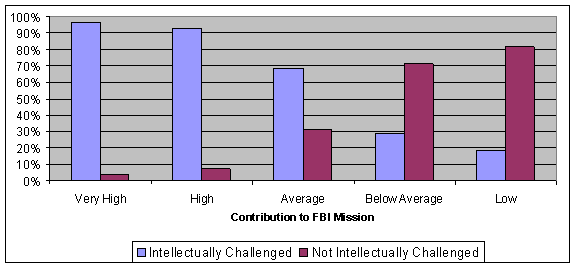
| Source: OIG survey of FBI intelligence analysts |
There is a similar link between analysts’ ratings of their contribution to the FBI mission and their satisfaction with the work assignments they receive. As the chart below illustrates, analysts who rate their contribution to the FBI as “very high” or “high” are much more likely to be satisfied with their work assignments than those analysts who rate their contribution as “below average” or “low.”
Contribution to FBI Mission by Satisfaction with Work Assignments53
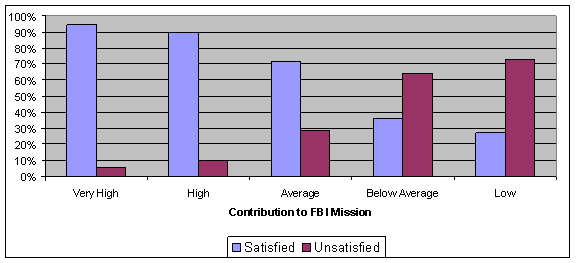
| Source: OIG survey of FBI intelligence analysts |
Satisfaction with Work Assignments
As shown in the chart below, the vast majority, 84 percent, of the analysts in our survey are satisfied with the work assignments they receive.
Intelligence Analyst Satisfaction with Work Assignments
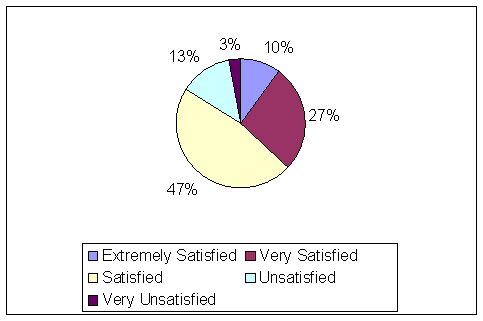
| Source: OIG survey of FBI intelligence analysts |
While the majority of the FBI’s intelligence analysts are satisfied with the work assignments they receive, certain categories of analysts are significantly less satisfied with their work assignments than intelligence analysts as a whole. As shown below, the following categories of analysts are less satisfied than all other FBI analysts with their work assignments: 1) working at FBI headquarters, 2) with advanced degrees, 3) hired within the last five years, and 4) Presidential Management Fellows.54
Groups of FBI Intelligence Analysts Expressing
A Higher Level of Dissatisfaction with the Work
Assignments They Receive55
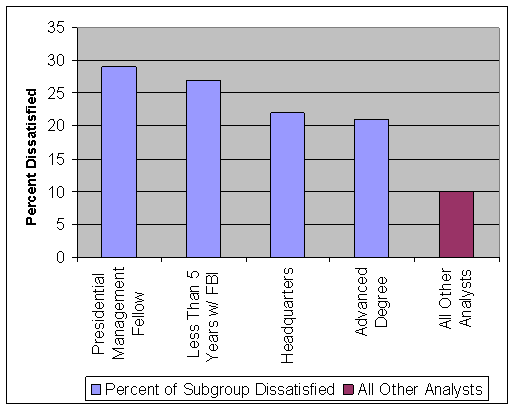
| Source: OIG survey of FBI intelligence analysts |
We performed statistical tests and found that respondents’ satisfaction with the work assignments they receive is statistically related to whether or not they have been employed by the FBI for five years or more and to their level of education.56 These tests showed that whether an analyst has been employed by the FBI for at least five years is an indicator of how satisfied that analyst is with the work assignments he or she receives. Likewise, the higher the level of education an intelligence analyst reported, the more likely that analyst is dissatisfied with his or her work assignments.
As shown in the chart below, 85 percent of the FBI’s intelligence analysts say they are challenged by their work assignments. However, among certain highly qualified categories of analysts, significant percentages of analysts reported not being as challenged as they could be.
Intellectual Challenge of the Intelligence Analyst Position
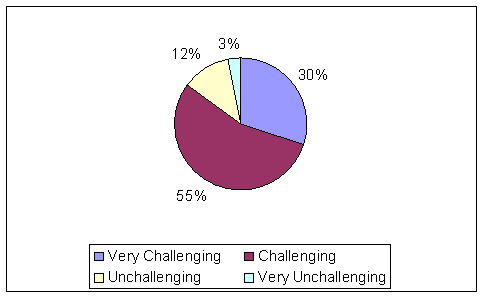
| Source: OIG survey of FBI intelligence analysts |
While most intelligence analysts think their work is at least intellectually challenging, some categories of analysts reported that their work is significantly less intellectually challenging than analysts as a whole. Specifically, the following categories of analysts reported that their work is less intellectually challenging than did other analysts who were not among these categories: 1) at headquarters, 2) advanced degrees, 3) employed by the FBI for less than five years, 4) Presidential Management Fellows, and 5) military intelligence experience.
Groups of FBI Intelligence Analysts Expressing
A Lower Level of Intellectual Challenge
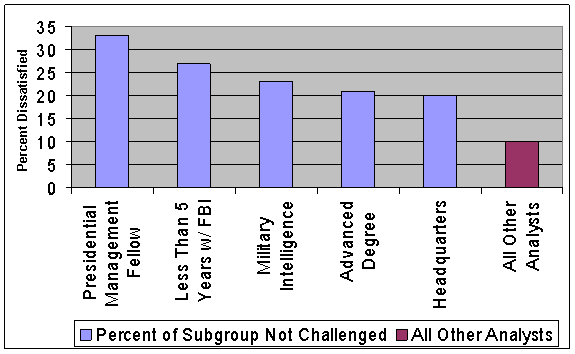
| Source: OIG survey of FBI intelligence analysts |
We performed statistical tests and found that the respondents’ level of intellectual challenge from the intelligence analyst position is statistically related to a number of variables. Most importantly, we found that the level of intellectual challenge posed by intelligence analysts’ work correlates to the level of satisfaction with their work assignments. As shown below, 86 percent of the analysts who reported being “very unsatisfied” with their work assignments also reported that they are not intellectually challenged by their work. Likewise, 100 percent of the intelligence analysts who reported being “extremely satisfied” or “very satisfied” with the work assignments they receive also reported being intellectually challenged.
Intelligence Analyst Satisfaction with Work Assignments
By Level of Intellectual Challenge Posed by Work57
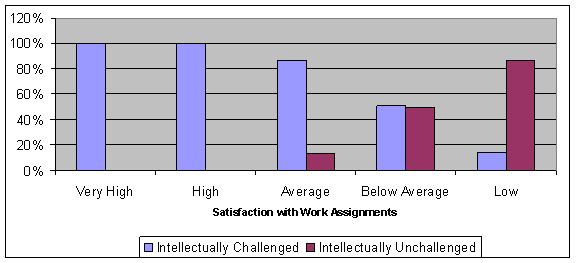
| Source: OIG survey of FBI intelligence analysts |
The other variables we identified that correlate with an intelligence analyst’s level of intellectual challenge include: whether they have been employed by the FBI for five years or more, their level of education, and whether they work at FBI headquarters. The statistical test we performed was a chi-squared analysis, which was discussed earlier. These tests showed that whether an analyst had been employed by the FBI for five years or more was an indicator of the level of intellectual challenge posed by their position. Specifically, analysts who have been employed by the FBI for five or more years are more likely to be intellectually challenged than those employed more recently. Likewise, the higher the level of education an intelligence analyst reported, the more likely that analyst is to feel intellectually unchallenged. Also, these tests showed a negative correlation between analysts working at FBI headquarters and the extent of intellectual challenge reported.
The Work of FBI Intelligence Analysts
In addition to hiring and training well-qualified analysts, the FBI’s intelligence program depends on the FBI using its analytical corps for its intended purpose: performing intelligence work and developing intelligence work products. We found that the type of work done by FBI intelligence analysts varies depending on grade, years of experience and location.
Broad Categories of Work
In our survey, we asked analysts to report what percentage of their time is spent on each of the following categories of work in an average month: 1) work requiring analytical skills, 2) program management, 3) administrative work related to being an intelligence analyst, and 4) administrative work not related to being an intelligence analyst.58 Overall, 57 percent of respondents reported they spend the majority of their time doing work that requires analytical skills. The majority of analysts also said they spend less than 25 percent of their time on program management activities, such as getting approval for warrants under the Foreign Intelligence Surveillance Act. Sixty-eight percent of analysts said they spend less than 25 percent of their time on administrative duties related to their job. Over 80 percent of analysts reported that administrative duties not related to their job take less than 25 percent of their time.
While 57 percent of the FBI’s intelligence analysts spend the majority of their time on work requiring analytical skills, 43 percent reported spending the majority of their time working on duties that do not require such skills.59 Further, 12 percent of respondents reported they spend the majority of their time on administrative duties. According to our survey, the average intelligence analyst spends his or her time as follows:
- 51 percent doing work requiring analytical skills,
- 13 percent doing program management,
- 20 percent doing administrative work related to being an intelligence analyst,
- 11 percent doing administrative work not related to being an intelligence analyst, and
- 5 percent doing other types of work.
Variations by Work Role
The amount of time analysts devote to these different types of work vary by the analysts’ specific roles in the general analyst job classification. On average, all source analysts reported spending more time doing work that requires analytical skills than reports officers and operational specialists. Of the three analyst roles, all source analysts spend the least amount of time on program management. On average, all source analysts spend 57.4 percent of their time doing work that requires analytical skills and 9.4 percent of their time on program management. In addition, only 9 percent of all source analysts reported spending 25 percent or more of their time on administrative duties not related to their job.60
How All Source Analysts
Spend Their Time
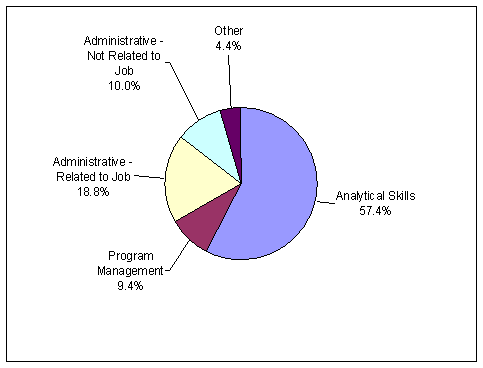
| Source: OIG survey of FBI intelligence analysts |
Of the three work roles, reports officers said they spend the least amount of time doing work that requires analytical skills. According to our survey, the average reports officer spends only 41 percent his or her time on work that requires analytical skills. However, reports officers were the most likely (22 percent) of the three types of analysts to say they spend the majority of their time on administrative duties related to their job. On average, reports officers said they are spending 25.9 percent of their time on administrative work related to being a reports officer.
How Reports Officers Spend Their Time
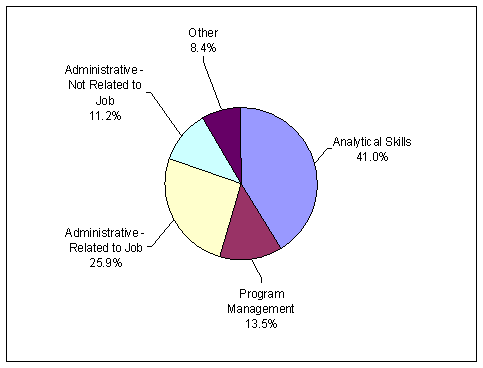
| Source: OIG survey of FBI intelligence analysts |
Of the three roles, the work done by operations specialists in headquarters and the field offices varies the most. As a whole, operations specialists reported spending 48.3 percent of their time on work requiring analytical skills and 16.1 percent of their time on program management. However, operations specialists at headquarters reported spending significantly less time on work requiring analytical skills and significantly more time on program management.
How Operations Specialists Spend Their Time
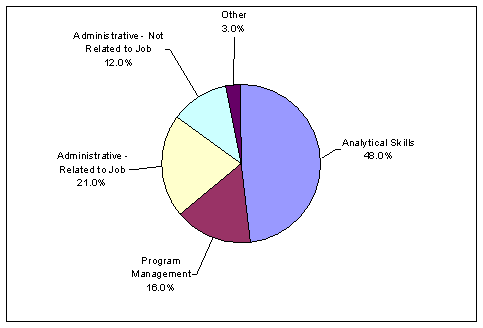
| Source: OIG survey of FBI intelligence analysts |
Operations specialists at headquarters reported spending only 29 percent of their time on work requiring analytical skills and 32.7 percent of their time on program management. Of the operations specialists assigned to one of the headquarters operational divisions, those in the Counterterrorism Division reported spending the least amount of time, 28 percent, on work requiring analytical skills. Of the operational divisions, operations specialists assigned to the Counterintelligence Division reported spending the most time, 43 percent, on program management. The chart below shows how the average headquarters operations specialist reported spending his or her time.
How Headquarters Operations Specialists Spend Their Time
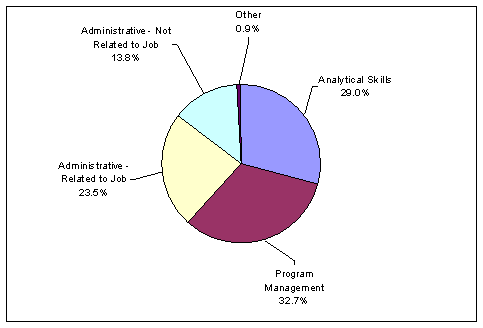
| Source: OIG survey of FBI intelligence analysts |
Through anecdotal reports, the EAD for Intelligence said she is aware of the high percentage of time that headquarters operations specialists spend on program management. She further said that she does not believe that all aspects of program management are appropriate work for intelligence analysts and would like to redefine the operations specialist role in a way that eliminates certain aspects of program management. She has asked the Analyst Advisory Group for its assistance in redefining the role of the operations specialist.61
Tasks and Intelligence Products
In our survey, we listed 19 tasks and asked intelligence analysts to tell us which specific tasks they had performed during the last three months. The responses show that the tasks intelligence analysts work on most frequently are not related to intelligence products disseminated to the intelligence community or to law enforcement. The five most frequently cited tasks in our survey were: 1) intelligence research to support specific field office cases (79 percent of respondents), 2) administrative duties (77 percent), 3) background checks and name checks (71 percent), 4) ECs on intelligence topics (61 percent), and 5) telephone analysis (55 percent).62
In our list of tasks, we itemized six intelligence products that are disseminated to the intelligence community or to law enforcement: 1) threat assessment, 2) Intelligence Information Report, 3) Intelligence Assessment, 4) Director’s Daily Report, 5) Intelligence Bulletin, and 6) Presidential Terrorism Threat Report.63 We recognize that the intelligence analyst position involves work other than disseminated intelligence products. For example, identifying intelligence gaps is a key mission of intelligence analysts. The FBI told us that it uses 27 metrics to evaluate the performance of its intelligence operations. However, we believe that disseminated intelligence products is a good performance measure for intelligence analysts and demonstrates how analysts are being used. The Directorate of Intelligence’s Performance Metrics Plan also includes the number of intelligence products produced by each analyst as one of its measures of performance.
For each of the 6 products listed, the percentage of intelligence analysts reporting they have worked on the product was less than 50 percent. Responses to these 6 intelligence products ranked as follows in a list of 19 total types of tasks performed by analysts:
- Threat Assessment, ranked 6th at 40 percent;
- Intelligence Information Report, ranked 7th at 33 percent;
- Intelligence Assessment, ranked 8th at 31 percent;
- Director’s Daily Report, ranked 13th at 14 percent;
- Intelligence Bulletin, ranked 15th at 11 percent; and
- Presidential Terrorism Threat Report, ranked 19th at 4 percent.
Some official FBI intelligence products — the National Report, the FBI Daily Report, and the Threat Matrix — were not included in our survey. We pretested our survey with intelligence analysts at headquarters and field offices, and we interviewed 25 intelligence analysts. None of these analysts told us that they worked on the products other than those included in our survey. Further, none of the “other” responses to our survey cited products other than those that were included.
According to our survey, 34 percent of analysts had not worked on any of the 6 intelligence products in our list of tasks. The majority of the respondents to our survey had worked on none or one of the six intelligence products. Further analysis of the survey results showed that analysts at headquarters, when compared to their colleagues in field offices, were more likely to have worked on more than two intelligence products and less likely not to have worked on any of the six intelligence products. Nearly 40 percent of the analysts located in field offices did not work on any intelligence products in the three months prior to taking our survey. Only 15 percent of analysts located in field offices reported working on more than two intelligence products. Based on the results of our survey, the following chart shows the differences, by location, in the number of intelligence products on which analysts worked.
Number of Intelligence Products Worked On
in the Last Three Months: By Location
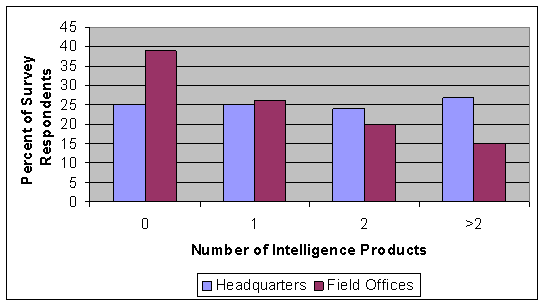
| Source: OIG survey of FBI intelligence analysts |
Analysts assigned to field offices are much more likely than analysts at headquarters to report they have performed a number of low-level intelligence tasks. Analysts at field offices are more likely than their headquarters counterparts to perform telephone analysis, background and name checks, and intelligence research to support specific field office cases. As discussed below, this data supports the information we obtained in our interviews with analysts.
We also found that analysts who have been employed by the FBI for five years or less are more likely to have worked on the disseminated intelligence products listed in our survey. As shown in the table below, intelligence analysts with five years or less experience were more likely than those with more tenure to report they have worked on the six intelligence products listed in our survey. Fifty percent of intelligence analysts with less than five years’ employment with the FBI reported they had worked on two or more intelligence products in the three months prior to our survey. Only 37 percent of analysts with 5 or more years of employment with the FBI said they had worked on a similar number of intelligence products.
Number of Intelligence Products Worked On
in the Last Three Months: by Length of Employment
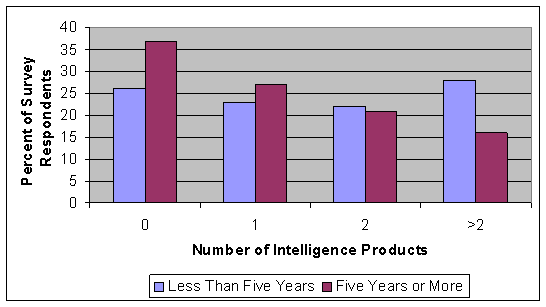
| Source: OIG survey of FBI intelligence analysts |
As shown above, 37 percent of the analysts with 5 or more years of employment with the FBI, compared to 26 percent of the analysts with less than 5 years, reported they had not worked on any of the disseminated intelligence products listed in our survey. However, analysts with more than 5 years of experience were more likely to report they recently worked on 5 of the 18 tasks listed in our survey: source validation, vetting new informants, intelligence research to support specific field office cases, background and name checks, and telephone analysis.
In addition to location and years of employment, we also found that analysts with advanced degrees, on average, reported they had worked on more of the six intelligence products listed in our survey than analysts without advanced degrees. Specifically, as shown in the chart below, we found that analysts with a masters or law degree, or a doctorate, were much more likely than analysts without advanced degrees to report they had worked on more than two intelligence products in three months prior to our survey. In addition, analysts with advanced degrees were the least likely of any group we measured not to have worked on any intelligence products. Only 21 percent of the analysts with advanced degrees reported they had not worked on any disseminated intelligence products in the 3 months prior to our survey.
Number of Intelligence Products Worked On
in the Last Three Months: by Level of Education
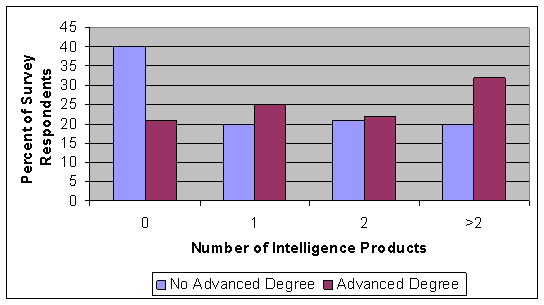
| Source: OIG survey of FBI intelligence analysts |
Intelligence Program Relies on Effective Use of Analysts
The FBI’s intelligence program relies on the FBI using its analysts for their intended purpose of conducting intelligence analysis and producing and disseminating intelligence products. The 9/11 Commission reported that prior to the September 11 attacks, the FBI did not use its intelligence analysts as effectively as it should have. The Commission found that, prior to the September 11 attacks, the FBI did not appreciate or understand the role of strategic analysis in driving investigations or allocating resources. Strategic analysts look across individual operations and cases to identify trends and develop broad assessments of threats. Strategic analysis should drive intelligence collection efforts because it is the only way for an organization to determine what it does not know. In contrast, tactical analysts provide direct support to investigations. According to the 9/11 Commission, FBI agents viewed tactical analysts as performing duties that advanced their investigative cases. Agents failed to see the value of strategic analysis, finding it too academic and seemingly irrelevant. As a result of this perception, prior to September 11, the FBI completed relatively few strategic counterterrorism analytical products.
The 9/11 Commission also reported on the FBI’s tradition of transferring personnel into analyst positions from other job categories rather than recruiting individuals with the relevant educational background and expertise. The 9/11 Commission identified several situations in which poorly qualified administrative personnel were promoted into analyst positions, in part as a reward for good performance in other positions. When the FBI hired or promoted people with appropriate analytical skills and experience, the FBI’s lack of a long-term career path and a professional training program caused many capable individuals to the leave the FBI or move internally to other positions. In addition, managers often did not use qualified analysts effectively, especially in the field offices. Some field analysts the Commission interviewed said that they were viewed as “über-secretaries,” and were expected to perform any duty that was deemed non-investigative, including data entry and answering phones. Headquarters managers often did not have sufficient staff support, so they, too, turned to analysts to perform policy-oriented, programmatic duties, and administrative tasks that were not analytical in nature.
During our interviews with intelligence analysts, we found that many analysts are still asked to perform non-analytical duties. In the field offices we visited, analysts told us that it is common for intelligence analysts to perform such tasks as escort, trash, watch, or command post duty. One analyst, who happens to have prior experience as an analyst and translator with another intelligence agency, told us of having to spend a week watching workers do repair work. Another analyst described escort duty as “demeaning.” As the name implies, escort duty is following visitors, such as contractors, around the FBI office to ensure that they do not compromise security.
Trash duty involves collecting all classified trash for incineration and delivering it to the appropriate place. Watch duty consists of answering phones and radios. At one smaller field office, an analyst reported that he is required to work nights and weekends as an operations security assistant – someone who operates the switchboard and escorts the cleaning people while they are in the office. Intelligence analysts said when they are assigned to command post duty, they entered data into Rapid Start, the FBI’s crisis response database.
Some analysts we interviewed said they were assigned these administrative duties regularly, but that the duties normally only took a relatively small percentage of their time. However, we found some instances in which intelligence analysts were permanently assigned to duties that we do not view as being related to intelligence analysis. For example, we interviewed one intelligence analyst, a GS-13 with an associate degree, who was assigned to an interagency task force. She told us she spends the majority of her time reviewing complaints of copyright infringement, to determine if the complaints meet the criteria necessary for the FBI or another agency to open an investigation. When she is not reviewing such complaints, she is providing “analytical support such as graphs and charts to Field personnel.” Because the unit to which she is assigned does not have sufficient administrative support, this analyst also prepares her unit’s timesheets.
Some analysts also complained about being assigned much administrative work. A number of analysts said that agents give intelligence analysts the administrative work the agents prefer not to do, such as Internet searches. One analyst said, “Special agents hate to do their own research, even it means finding out who the new SAC in Kansas City is.” Another analyst told us “A lot of my job doesn’t require a college education.” Many analysts told us that most intelligence analysts do very little analysis; instead, the work assigned them is what they classify as investigative support.
The EAD for Intelligence told us she is concerned about the non-analytical tasks being asked of analysts due to the lack of sufficient administrative support. She also said that she has removed her own classified trash and that special agents perform escort duty and other administrative tasks. However, analysts we interviewed perceive that analysts are much more frequently asked to perform extraneous duties than are agents.
Role of Intelligence Analysts Misunderstood
Intelligence analysts identified three main causes for why they believe they are not always used to for analytical purposes.
FBI special agents do not understand the capabilities or functions of intelligence analysts. Twenty-seven percent of survey respondents reported that agents rarely or never understand the role of intelligence analysts. Analysts assigned to headquarters or hired within the last five years were more likely to be concerned about the role of intelligence analysts at the FBI.
Among analysts at FBI headquarters, 33 percent responded “rarely” or “not at all” to our question about agents’ understanding of the functions of intelligence analysts. Thirty-six percent of the analysts with advanced degrees and 40 percent of the analysts hired within the last 5 years replied “rarely” or “not at all” to the question. In comparison, only 12 percent of the respondents with an associates degree had a similar response.
The analysts we interviewed, both at headquarters and in the field, believed that some of this misunderstanding between agents and analysts could be mitigated by integrating at least part of the new agent training and the basic intelligence analyst training. As part of that integrated training, some analysts thought a case study would be very helpful.
Most analysts are supervised by special agents. Many analysts with whom we spoke believe that they should be supervised by other analysts, not by special agents. They believe that other analysts best know their functions and capabilities and can therefore make the best use of the FBI’s analytical capabilities.
The FBI does not have enough administrative personnel. The EAD for Intelligence recognizes that the FBI does not have enough administrative personnel, causing intelligence analysts to be asked to perform administrative functions. Some of the analysts we interviewed agreed, saying they could accept being asked to do administrative duties because the FBI did not have enough administrative personnel and the nation’s security is at stake.
The FBI has recognized the need to enlarge and professionalize its analytical corps, and it is taking steps to do so. In our judgment, however, one impediment is the level of work that analysts are asked to perform. The FBI must ensure that its analysts receive work that is analytical in nature and is not overly burdened by routine administrative duties. The FBI also needs to ensure that its analysts receive challenging work assignments if the FBI is to build and maintain a professional and well-respected analytical corps.
During our audit, we found that intelligence analysts 1) at FBI headquarters, 2) with less than five years of employment, and 3) having an advanced degree, are more likely to have worked on disseminated intelligence products. However, analysts with these same attributes are also more likely to express dissatisfaction with the work assignments they receive and the intellectual challenge of their work. We attribute much of this dissatisfaction to the high expectations these analysts have about their work. We also believe that many special agents do not completely understand the role of analysts in an intelligence agency. We found that many FBI managers are committed to the difficult task of changing the FBI’s culture from an investigative agency to an investigative agency with an intelligence function and a common goal of preventing additional terrorist attacks. Having special agents understand the role of analysts and work as partners with them is a major part of the required cultural change.
We recommend that the FBI:
- require all special agents to attend some mandatory training on the role and capabilities of intelligence analysts,
- assess the work done by intelligence analysts and determine what work is analytical in nature and what work is in general support of investigations that can more efficiently be performed by other support or administrative personnel, and
- develop a strategic workforce plan for intelligence support personnel, and include in that plan a gap analysis of current investigative support personnel (by position) and the number (by position) the FBI needs to meet current and forecasted threats.
Finding 5: Retaining Intelligence Analysts
To achieve its strategic objective of a well-educated, highly trained, and appropriately sized analytical work force, the FBI must retain well trained and productive intelligence analysts. In FYs 2002 – 2004, 291 intelligence analysts left the FBI’s analytical corps.64 Of the 291 analysts, 57 percent left the FBI entirely, and 43 percent transferred to other jobs within the FBI. The turnover rate for intelligence analysts has decreased for two consecutive fiscal years, from 10 percent in FY 2002 to 9 percent in FY 2003 and 8 percent in FY 2004.65 The turnover rate for FBI intelligence analysts was higher at headquarters than in its 56 field offices.
Our survey found that 63 percent of the FBI’s analysts plan on staying with the FBI as intelligence analysts for the next five years. However, we also found that analysts 1) assigned to headquarters, 2) hired in 2002 - 2004, and 3) possessing advanced degrees are less likely to say they will remain as FBI intelligence analysts. Analysts who are Presidential Management Fellows or have military intelligence or intelligence community experience are also less likely to say they will stay with the FBI. Analysts who reported they do not plan on staying with the FBI as an intelligence analyst cite a number of reasons for departing, including issues involving retirement, promotion and pay, and morale.
Attrition in the Analytical Corps, FYs 2002 - 2004
From the beginning of FY 2002 through July 8, 2004, 291 intelligence analysts left the FBI’s analytical corps. Of the 291 analysts who left, 165 left the FBI entirely and 126 took other positions within the FBI. Based on the first 9 months of FY 2004, we project that the FBI will lose 110 intelligence analysts in FY 2004: 71 will leave the FBI entirely and 39 will take other positions within the FBI.
To achieve its strategic objective of a well-educated, highly trained, appropriately sized analytical work force, the FBI recognizes that it must retain its well trained and productive intelligence analysts. According to the Human Talent CONOPS, “Onboard Analysts represent the past, present, and future of the analytical program at the FBI. New hires will need to rely on the analytical and organizational expertise of the current complement in order to succeed.” However, the CONOPS does not address the retention of analysts. The Office of Intelligence told us it is actively managing the retention of intelligence analysts by activities such as constantly monitoring the attrition rate and surveying intelligence analysts to understand their career needs.
As shown below, the turnover rate for intelligence analysts has decreased for two consecutive fiscal years. Despite these decreases, in FY 2004, the turnover rate for intelligence analysts was still 25 percent higher than the rate for other non-agent personnel.
Turnover Rates of FBI Employees,
FYs 2002 - 2004
| FY 2002 % | FY 2003 % | FY 2004 % | |
|---|---|---|---|
| Intelligence Analysts | 10 | 9 | 8 |
| Special Agents | 5 | 5 | 5 |
| Other Non-agent Personnel | 5 | 5 | 6 |
| Source: OIG Analysis of FBI data |
While the analyst turnover rate decreased in the last two fiscal years, the total number of analysts leaving the analyst corps increased. For example, between FY 2002 and FY 2004, the number of intelligence analysts leaving the analytical corps increased 10 percent. In addition, in that same period, the number of analysts leaving the FBI entirely increased 79 percent, from 42 in FY 2002 to 75 in FY 2004. The graph below shows the total number of analysts who left the FBI’s analytical corps in FYs 2002 - 2004, and whether they left the FBI entirely or transferred to other positions within the FBI.
Intelligence Analyst Attrition, FYs 2002-2004
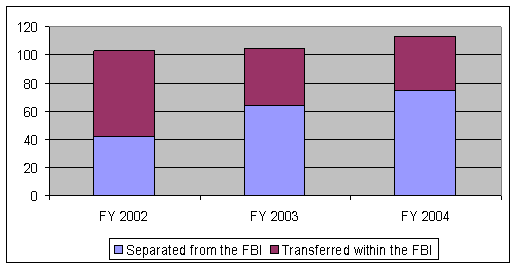
| Source: OIG Analysis of FBI data |
The EAD for Intelligence told us she was pleased with the 8 percent turnover rate in FY 2004 because the rate declined from the previous year and because she believes this rate compares favorably with the rest of the intelligence community. We attempted to compare the turnover rate of FBI intelligence analysts with that of the DIA and the CIA. However, both agencies declined to provide us with the classified data to perform that calculation.
As shown below, for FYs 2002 - 2004, the turnover rate for intelligence analysts has been higher at FBI headquarters than at its 56 field offices.
Turnover Rates of FBI Intelligence Analysts,
FYs 2002 - 200466
| FY 2002 % | FY 2003 % | FY 2004 % | |
|---|---|---|---|
| Headquarters | 15 | 14 | 8 |
| Field Offices | 7 | 5 | 5 |
| Other Offices | 4 | 12 | 3 |
| Entire FBI | 10 | 9 | 6 |
| Source: OIG Analysis of FBI data |
Of the 165 analysts who left the FBI entirely during FYs 2002 through July 8, 2004, 97 were assigned to headquarters, 57 were assigned to field offices, and 11 were assigned to other units. Analysts at the GS-11 grade (38 percent) were the most likely to leave the FBI entirely. In addition, GS-11 analysts were the most likely to transfer to other positions within the FBI.
The 126 analysts who left the analyst corps to take other positions within the FBI transferred to 21 different job series ranging from information technology management to secretary. As shown below, the job series to which analysts most frequently transferred was the management and program analysis series. This series includes positions such as program analyst. The second most frequent position to which analysts transferred was special agent. In FYs 2002 - 2004, 26 intelligence analysts became special agents.
Job Series to Which Intelligence Analysts Transferred,
FYs 2002 - 200467
| Job Series | Job Series Description | Employees | Percent |
|---|---|---|---|
| 80 | Security Administration | 4 | 3.2 |
| 134 | Intelligence Aid and Clerk | 2 | 1.6 |
| 201 | Human Resources Management | 2 | 1.6 |
| 260 | Equal Employment Opportunity | 1 | 0.8 |
| 301 | Miscellaneous Administration and Program | 17 | 13.5 |
| 303 | Miscellaneous Clerk and Assistant | 6 | 4.8 |
| 318 | Secretary | 3 | 2.4 |
| 326 | Office Automation Clerical and Assistance | 1 | 0.8 |
| 340 | Program Management | 1 | 0.8 |
| 343 | Management and Program Analysis | 30 | 23.8 |
| 560 | Budget Analysis | 1 | 0.8 |
| 905 | General Attorney | 1 | 0.8 |
| 950 | Paralegal Specialist | 3 | 2.4 |
| 1035 | Public Affairs | 1 | 0.8 |
| 1082 | Writing and Editing | 1 | 0.8 |
| 1702 | Education and Training Technician | 2 | 1.6 |
| 1712 | Training Instruction | 4 | 3.2 |
| 1801 | General Inspection, Investigation, and Compliance | 11 | 8.7 |
| 1802 | Compliance Inspection and Support | 5 | 4.0 |
| 1811 | Special Agent | 26 | 20.6 |
| 2210 | Information Technology Management | 4 | 3.2 |
| TOTAL | 126 | 100.0 |
| Source: The FBI |
Our survey showed that 63 percent of the FBI’s current intelligence analysts plan on staying with the FBI as intelligence analysts for the next 5 years. However, the remaining 37 percent of analysts either did not plan on remaining FBI analysts or did not know whether they would remain. We performed statistical tests and found that the following variables correlate most strongly with the analysts’ views on wanting to stay in the FBI:
- job assignment (headquarters or field office),
- level of education, and
- length of employment with the FBI.
As detailed below, the likelihood an analyst would stay with the FBI negatively related to an analyst being assigned to headquarters and his or her level of education. The likelihood that an analyst would stay is positively related with his or her length of employment with the FBI.
While 18 percent of the analysts in field offices reported it is “unlikely” or “very unlikely” they will remain in their current positions, 28 percent of the analysts at headquarters responded similarly. The following table shows the dissimilarity of the views of headquarters and field office analysts on the likelihood they will stay with the FBI as an intelligence analyst.
Likelihood Analysts Will Stay with the FBI
for the Next Five Years: By Job Assignment
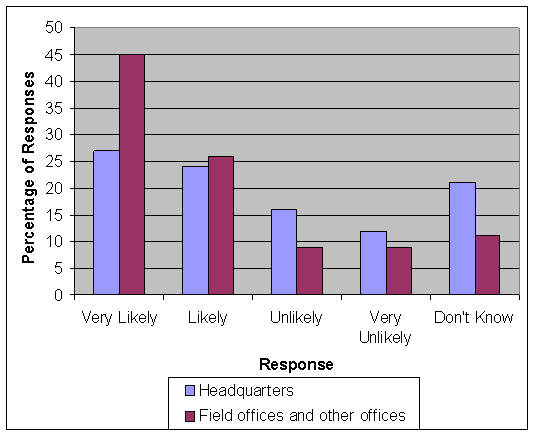
| Source: OIG survey of FBI intelligence analysts |
We found that having less than five years of employment with the FBI is an indicator that an analyst does not plan to remain in that position for at least the next five years. The opposite is also true: having five years or more of FBI employment is an indicator that an analyst plans to stay in that position. Given the FBI’s strategic goal of building an appropriately sized analytical corps and the FBI’s hiring efforts in the last three years, it is especially important that the FBI retain the analysts it has recently hired. If a high percentage of analysts rotate out of the FBI after three years, it will be difficult for the FBI to build its analytical corps – both in terms of quality and quantity. We found that 35 percent of intelligence analysts hired since 2002 do not plan to remain in those positions for the next five years. Only 16 percent of these newly hired analysts said they are very likely to stay for the next five years. Of the analysts hired prior to FY 2002, only 19 percent reported they are not likely to stay with the FBI as an intelligence analyst for the next five years and 45 percent said they are very likely to stay. The chart below shows the differences in the views between analysts hired prior to 2002 and analysts hired in 2002 and after.
Likelihood Analysts Will Stay with the FBI
for the Next Five Years: By Year Hired
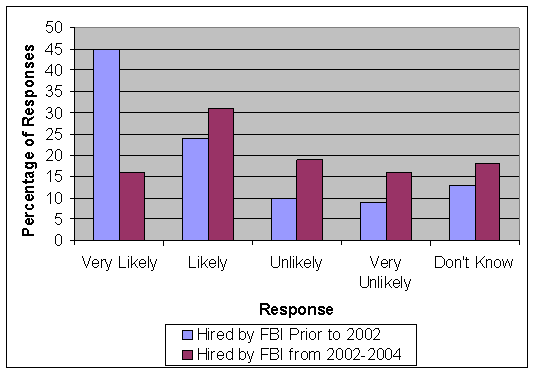
| Source: OIG survey of intelligence analysts |
We also found a statistical relationship between an analyst’s level of education and the likelihood the analyst will stay with the FBI in that position for at least the next five years.68 Specifically, we found that the higher an analyst’s level of education, the less likely he or she is to remain. Given the FBI’s goal of developing a well-educated analytical corps, it is especially important that the FBI retain its analysts with advanced degrees. However, our survey data shows that the FBI’s better-educated analysts are more likely to leave the analytical corps than its less–educated ones. The graph below shows the likelihood that analysts at each educational level will remain as an FBI analyst for the next five years.
Likelihood Analysts Will Stay with the FBI
for the Next Five Years: By Educational Level
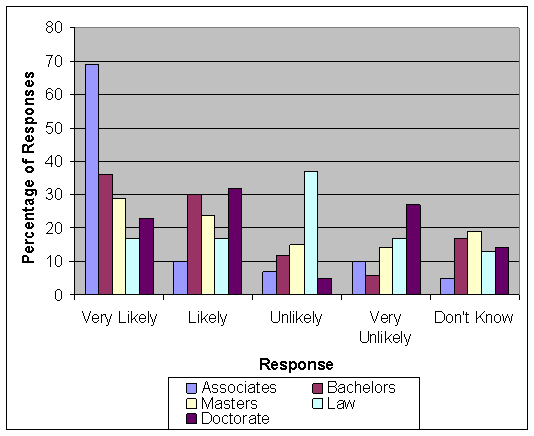
| Source: OIG survey of FBI intelligence analysts |
In addition to examining variables that have a statistical correlation with the likelihood that an analyst will stay with the FBI for the next five years, we also examined the views of key categories of analysts in our survey. We reviewed the likelihood that Presidential Management Fellows, analysts with military intelligence experience, and analysts with intelligence community experience will stay with the FBI as analysts for the next five years. As shown in the following chart, we found that Presidential Management Fellows are less likely to report that they expect to remain at the FBI than analysts who are not Presidential Management Fellows.
Likelihood Analysts Will Stay with the FBI
for the Next Five Years:
Presidential Management
Fellows and All Other Analysts
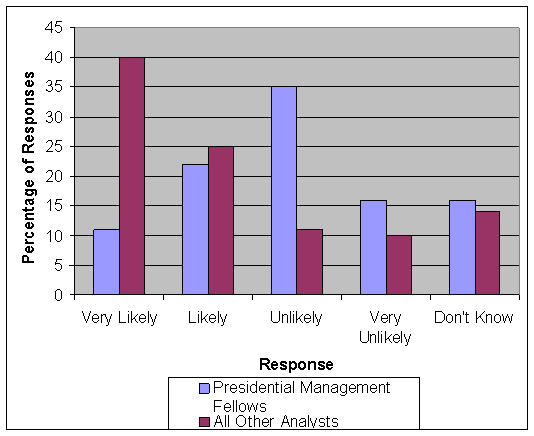
| Source: OIG survey of FBI intelligence analysts |
We also found that analysts with prior military intelligence experience are also less likely to remain with the FBI as intelligence analysts. The chart below shows the difference in the views of analysts with military intelligence experience and all other FBI analysts concerning the likelihood they will remain in their current positions for at least five years.
Likelihood Analysts Will Stay with the FBI
for the Next Five Years: Analysts with Military
Intelligence Experience and All Other Analysts
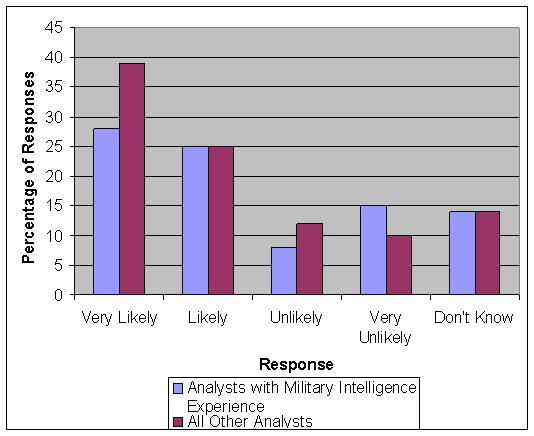
| Source: OIG survey of FBI intelligence analysts |
We found that the views of analysts with intelligence community experience on this topic are very similar to those with military intelligence experience. Fifty-five percent of the analysts with intelligence community experience and 59 percent of those with military intelligence experience said they would remain as FBI analysts. Likewise, 27 percent of analysts with intelligence community experience and 26 percent of those with military intelligence experience said they would not remain. However, as shown below, we found that analysts with previous intelligence community experience were less likely to stay with the FBI in their current positions than all other FBI analysts.
Likelihood Analysts Will Stay with the FBI for the
Next Five Years: Analysts with U.S. Intelligence
Community (USIC) Experience and All Other Analysts

| Source: OIG survey of FBI intelligence analysts |
The FBI does not conduct exit interviews when analysts leave the FBI, nor does it collect any other data on the reasons for attrition. Our survey asked those analysts who said they were unlikely to remain to explain why. In addition, our survey showed a number of statistical correlations that provide insights into the reasons analysts are leaving the FBI’s analytical corps.
Although we found variations in the reasons analysts cited for why they do not intend to remain, when we considered education and length of FBI employment overall, we identified 8 reasons cited by 5 percent or more of the analysts.69
Reasons FBI Intelligence Analysts Cited
for Why They Would Not Stay with the FBI
as Intelligence Analysts for the Next Five Years
| Reason Cited70 | Percentage of Respondents |
|---|---|
| Retirement | 20 |
| Promotion/Pay/Benefits | 16 |
| Morale/FBI Management | 11 |
| Work Assignments/Role | 10 |
| Change Careers (including becoming a special agent) | 9 |
| Lack of Respect | 8 |
| Lack of Challenge | 8 |
| Work for Another Intelligence Agency | 5 |
| Source: OIG analysis of survey comments |
Retirement
The Office of Intelligence recognizes the succession planning challenge presented by the retirement eligibility of its current analysts. According to the Human Talent CONOPS, approximately 17 percent of the FBI’s current analysts will be eligible to retire within the next 5 years. Retirement and increased analytical needs are the two factors that the FBI attributes for its need to hire a large number of analysts in the near future. In our survey, retirement was the most frequently cited reason given by analysts who plan on leaving the FBI.
Promotion, Pay, and Benefits
Sixteen percent of analysts cited issues concerning promotion, pay, and benefits as the reason they do not expect to remain in their current positions. For analysts with less than five years of FBI employment, issues concerning promotion, pay, and benefits were the most frequently cited reason for them not intending to stay with the FBI. Both our survey and our interviews with analysts indicated that both the FBI’s promotion policy and analysts’ promotion potential are issues that concern them.
In our survey, we found the likelihood that an analyst will remain in his or her current position is statistically related to that analyst’s opinion of the FBI’s promotion policy. Specifically, we found that analysts are less likely to think they will stay with the FBI for the next five years, if they are not satisfied with the way the FBI’s promotion process has been applied to them. In addition, we found that analysts’ views about the likelihood of their promotion up to a GS-14 are statistically related with their views about whether they will remain at the FBI. Analysts who think they are likely to reach a GS-14 were likely to say they will stay. Finally, we found that analysts’ satisfaction with the FBI’s promotion policy is statistically linked to whether they plan to remain as an FBI analyst. In other words, analysts who are satisfied with their promotion potential are more likely to say they will remain with the FBI as an analyst for the next five years.
In our interviews, analysts expressed a variety of concerns about the FBI’s promotion policy and the promotion potential for their job series. Some analysts want the potential to be promoted to a level equivalent to the SES. These analysts said they would not remain with the FBI if the ability for promotion is blocked. Many analysts in field offices thought they would not be promoted to GS-14 because the GS-14 administrative officer, to whom analysts used to report, often serves on promotion boards and would not allow a former subordinate to have the same grade.
Some analysts said the type of work necessary for a promotion was not available to them. Specifically, analysts assigned to field offices and operations specialists at headquarters said their normal work duties did not allow them the time to write the types of intelligence products required for promotion. One analyst said she has to self-initiate products and also perform her normal duties. Other analysts said it was more difficult for analysts assigned as reports officers and operations specialists to be promoted. They said the promotion guidelines are geared toward the all source intelligence analyst function, and the criteria for promotion do not reflect the kind of work they are asked to perform. Some analysts think the promotion process is unfair when compared to the promotion policy for special agents. These analysts assert that the promotion process for agents up to a GS-13 is much less rigorous and time-consuming than the promotion process for intelligence analysts.
The Office of Intelligence recognizes that pay and benefits are a major issue in retaining intelligence analysts and believes that the FBI has been at a competitive disadvantage because it has had to comply with the pay provisions of Title 5 of the U.S. Code. In that regard, the Office of Intelligence believes the Intelligence Reform and Terrorism Prevention Act of 2004 provides the FBI with the flexibility to compete with other intelligence agencies and the private sector for intelligence analysts.
The FBI has also taken other steps, such as establishing a student loan repayment program, to improve the benefits it offers intelligence analysts. The FBI has repaid a portion of 41 analysts’ student loans. In return, these analysts signed 3-year service agreements.
Morale and FBI Management
In our survey, 11 percent of analysts reported they will not stay with the FBI because of issues concerning morale, work atmosphere, and management. These issues are the second most frequently cited reason by analysts with less than five years of experience reported for not intending to stay with the FBI. Most analysts we interviewed value the role of the Office of Intelligence, and said the Office has made significant progress although it has a lot of work to do. However, many analysts we interviewed are upset with the Office of Intelligence as a result of what is known as the “migration.” The migration, which began before the EAD for Intelligence position was created, was an attempt by the Office of Intelligence to improve the quality of the FBI’s analytical corps by requiring a college degree for the intelligence analyst position but also mandating that analysts reapply for their current jobs. The migration was canceled before the process was completed, but many analysts had already taken the time and effort to reapply for the jobs they currently held. Other analysts said that the attrition rate in their office or unit is high and that the level of attrition has a detrimental effect on the morale of the remaining analysts.
In discussing the job satisfaction of the FBI’s analysts, the EAD for Intelligence told us that while she is concerned about analysts’ job satisfaction, her focus is on creating an effective intelligence analysis capability. She pointed out that happy intelligence analysts may or may not be effective. In other words, job satisfaction (or morale) may not correlate with results. While we understand and agree with the EAD for Intelligence’s need to concentrate on establishing an effective intelligence program, we believe that morale can affect job performance and most certainly can affect attrition. For these reasons, morale or satisfaction is one of the factors that warrant attention to help reduce attrition. After our audit had ended, the Office of Intelligence told us that it plans to conduct an employee satisfaction survey in the second half of FY 2005. The Office of Intelligence’s Performance Metrics Plan includes the satisfaction survey as a measure of the Office’s planning and budgeting efforts.
Role of Intelligence Analysts
Much of the dissatisfaction analysts expressed with morale and FBI management appears to be linked to the role of intelligence analysts and their work assignments. In our survey, we found that analysts’ satisfaction with their work assignments is statistically related with the likelihood they will stay with the FBI. As shown below, 81 percent of analysts who are extremely satisfied with their work assignments are also likely to remain at the FBI.
Likelihood Analysts Will Stay with the FBI
and Analysts’ Satisfaction with Work Assignments71
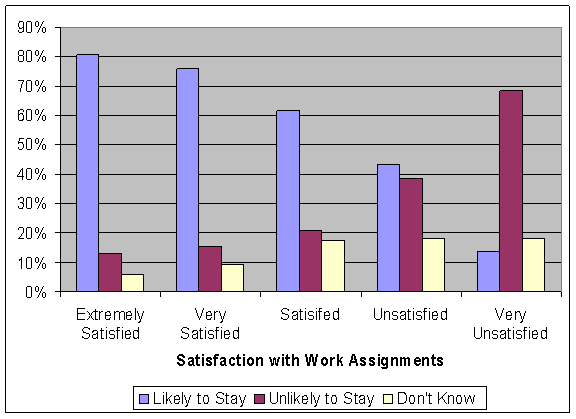
| Source: OIG survey of FBI intelligence analysts |
As we noted in Finding 4, many analysts said that special agents do not always understand the capabilities and functions of intelligence analysts. Their opinions on this issue are also statistically related with whether or not they will stay with the FBI. Numerous analysts told us they are utilized as investigative support personnel rather than as intelligence analysts.
The EAD for Intelligence said she is committed to providing the FBI’s intelligence analysts with the tools and techniques to be effective intelligence analysts. However, she is uncertain whether all of the FBI’s intelligence analysts want to be analysts, as opposed to special agents or case support personnel. She also said that if she could be sure all of the FBI’s intelligence analysts are actually doing analytical work, she might not need as many intelligence analyst positions. However, she said she does not have the data to determine whether all analysts are doing analytical work. She said the Office of Intelligence is currently working on developing that data through a telephone survey it conducted.
Change Careers
Nine percent of the analysts who reported they do not expect to stay with the FBI told us that they intend to try a new job outside of the intelligence analyst field. A significant number of these analysts said they want to become FBI special agents. In our judgment, special agents who have had previous experience as intelligence analysts would be a significant resource for the FBI, but paradoxically would harm efforts to build the FBI’s intelligence analyst corps.
Respect
Eight percent of the analysts who said they do not intend to stay with the FBI reported that issues concerning lack of respect for intelligence analysts were the reason they would leave. Analysts in the FBI’s field offices were more likely to cite lack of respect as a reason for leaving the FBI than their headquarters colleagues: 14 percent of field office analysts and 6 percent of headquarters analysts said that lack of respect is their reason for considering leaving the FBI. In our interviews, analysts repeatedly told us that the lack of respect they feel boils down to one concept: analysts are labeled “support” personnel rather than intelligence analyst professionals on par with the FBI’s special agents. Some analysts said the support label leads some agents to treat analysts as if they were clerks. One analyst made a military analogy and said that agents are like officers in the military and analysts are like enlisted personnel. In our survey, we asked analysts to tell us whether the term “support staff” evokes a negative feeling in them when applied to intelligence analysts, and 60 percent said yes.
We also found that analysts’ opinions on the use of the term “support staff” statistically correlate with several variables. Specifically, we found that opinions about the term “support staff” positively correlates with level of education and negatively correlate with length of employment. As shown below, the higher an analyst’s level of education, the more likely that analyst is to be offended by the term “support staff” to describe intelligence analysts.
Intelligence Analysts’ Feelings About the
Term “Support Staff”: By Level of Education
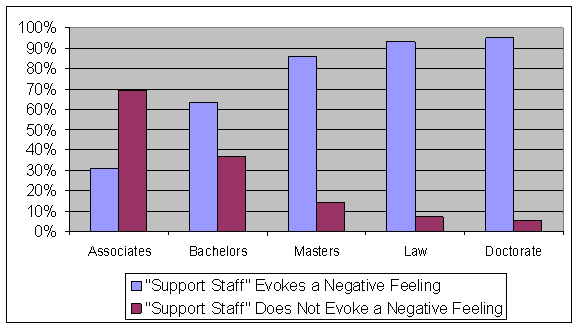
| Source: OIG survey of FBI intelligence analysts |
The opposite correlation is true for length of employment. As shown below, analysts who have been employed by the FBI for five years or more are much less likely to be offended by the use of the term “support staff” to describe intelligence analysts.
Intelligence Analysts’ Feelings About the
Term “Support Staff”: By Length of Employment
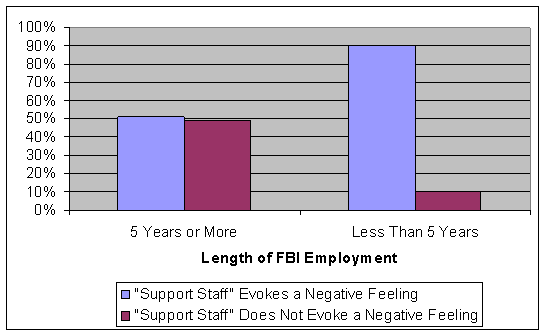
| Source: OIG survey of FBI intelligence analysts |
Lack of Challenge
Issues concerning a lack of challenge in the intelligence analyst position were the eighth most frequently cited reason for analysts not intending to stay with the FBI. In our survey we found that responses to our questions about intellectual challenge and the likelihood an analyst will stay with the FBI are statistically related. Specifically, we found that responses to our question about the intellectual challenge of the analyst position positively relates with the question about whether they intend to stay with the FBI. As shown below, 93 percent of the analysts who find their work intellectually challenging said that they are very likely to remain as FBI intelligence analysts. In contrast, 32 percent of the analysts who do not find their work intellectually challenging said that it is very unlikely they will remain as an FBI analyst.
Likelihood of Remaining an FBI Intelligence Analyst:
By Level of Intellectual Challenge Posed by Work72
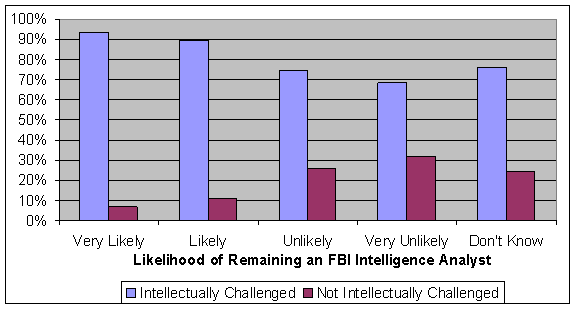
| Source: OIG survey of FBI intelligence analysts |
Work for Another Intelligence Agency
Five percent of the respondents to our survey said they will not stay at the FBI as an analyst because they intend to work for another intelligence agency. Intelligence analysts in field offices, with five or more years of FBI employment, and without advanced degrees are more likely than their colleagues to state this reason for leaving the FBI.
The Office of Intelligence recognizes that the FBI competes for analysts with other intelligence agencies and believes that other intelligence agencies have had a competitive advantage over the FBI because many of the agencies do not have to comply with the pay provisions of Title 5 of the U.S. Code. In that regard, the Office of Intelligence believes the Intelligence Reform and Terrorism Prevention Act of 2004 provides the FBI with the flexibility to compete with other intelligence agencies for intelligence analysts.
While the turnover rate for intelligence analysts has decreased each of the past two fiscal years, the turnover rate for intelligence analysts in recent years has been nearly double that of all other FBI employees, including special agents. As a result, we are concerned about the effect attrition may have on the FBI’s efforts to build a highly effective and well-qualified analytical corps. Given that less than half of the analysts hired in the last three years said it is “likely” or “very likely” they will stay with the FBI for at least the next five years, the FBI needs to focus attention on developing a strategy to retain these new analysts. The intelligence analysts hired within the last three years are especially valuable. As a group, these analysts are better educated and better qualified than the FBI’s analyst population as a whole. While the FBI is aware of many of the underlying causes for attrition in the analyst corps, we believe that some of the causes merit more attention. Specifically, the FBI’s new promotion process for analysts has not been well-received by the analytical corps. Also, the issue of lack of respect or analysts feeling like “second class citizens” continues to be a major concern for intelligence analysts and needs to be remedied. We believe that the FBI should develop a retention plan for the effective and productive analysts already in its analytical corps and a succession plan to deal with upcoming retirements.
We recommend that the FBI:
- develop retention and succession plans and strategies for its intelligence analysts, including measurable goals, and
- conduct exit interviews of intelligence analysts who leave the FBI entirely or transfer to other positions within the FBI.
Footnotes
- Before issuing this report, we asked the FBI to update the total number of intelligence analysts employed as of September 30, 2004. However, throughout the report we primarily cite data from October 1, 2001, through July 8, 2004.
- We use the term “transfer” to describe analysts hired from within the FBI. According to the FBI, internal hires must meet the same standards as analysts hired from outside of the FBI.
- The 291 analysts who left their positions for other jobs includes 15 analysts who were transferred with the National Infrastructure Protection Center to the Department of Homeland Security.
- FY 2004 data is through July 8, 2004.
- An FBI employee’s entry-on-duty date is the date that employee began employment with the FBI, regardless of any changes in that employee’s position.
- FY 2004 data is through July 31, 2004.
- According to the OPM, the Presidential Management Fellows program is designed to attract to the federal service outstanding graduate students from a wide variety of academic disciplines who demonstrate an exceptional ability for leadership in the analysis and management of public policies and programs.
- Foreign language proficiency was self-assessed by the analysts in our survey.
- FY 2004 data is through July 8, 2004.
- FY 2004 data is through July 8, 2004.
- Due to rounding, the sum of the percentages in this table does not equal 100 percent.
- FY 2004 data is through July 8, 2004.
- FY 2004 data is through July 8, 2004.
- The report is entitled, A Review of the Federal Bureau of Investigation’s Counterterrorism Program: Threat Assessment, Strategic Planning, and Resource Management.
- Minimally qualified means the applicant meets the basic and essential requirements for the position. The minimum qualifications for a position may include educational requirements and selective placement factors specific to the position.
- At the time of our audit, the FBI conducted its own background investigations. The Intelligence Reform and Terrorism Prevention Act of 2004 also addresses the need to streamline the process by which government agencies grant security clearances. The Act directs the President to select a single entity to conduct all security clearance investigations.
- FY 2004 data is through July 8, 2004. The July projection is based on the average number of background investigations initiated each business day from July 1, 2002 through July 8, 2004.
- Each of 210 background investigations discontinued in FYs 2002 and 2003 may or may not be one of the 433 background investigations initiated during the same period. Some of the background investigations discontinued during FYs 2002 and 2003 may have been initiated prior to the start of FY 2002.
- FY 2004 data is through July 8, 2004.
- See Appendix 5 for a list of the intelligence community agencies.
- Until September 2003, the career path for analysts in FBI field offices was limited to GS-12.
- The report is entitled A Model of Strategic Human Capital Management (GAO-02-373SP), dated March 2002.
- We did not gather data on the allocation process prior to FY 1996.
- The FBI originally received an enhancement of 817 intelligence analyst positions, but 30 of these positions were converted to financial analysts and allocated to the Criminal Investigative Division.
- A Future Threat Forecast assesses future threats that will drive FBI operations and operational environments. The forecast will be the primary basis for Operational Impact Assessments to be used to determine operational requirements. An Operational Impact Assessment will translate the high-level assessment in the Future Threat Forecast into planning information for FBI managers. Both the Future Threat Forecast and the Operational Impact Assessment are to be produced annually and used to support strategic planning and budgeting.
- The Intelligence Production Board is an FBI-wide advisory board that coordinates the production of short- and long-term intelligence products. The Board is made up of representatives from each FBI headquarters investigative division and the Office of Intelligence. The EAD for Intelligence chairs the Board, which meets daily.
- In addition to the BIA, the CAS also offers specialty courses in a variety of subjects, including analytical methods, denial and deception, Lexis/Nexis, money laundering, and statement analysis. The CAS also collaborates with other intelligence community training institutions so that FBI analysts can obtain additional specialized training.
- Because respondents could check more than one response, the sum of the percentages does not equal 100.
- FY 2004 data is through April 19, 2004.
- In commenting on a draft of this report, the EAD for Intelligence said that the Office of Intelligence is responsible for choosing the order in which the course material is presented and for vetting instructors. The contractor only provides advice to the FBI on these aspects of the course.
- A SCIF is an accredited area, room, group of rooms, buildings, or installation where Sensitive Compartmented Information may be securely stored, used, discussed, or processed.
- In reviewing a draft of this report, the EAD for Intelligence said that the Office of Intelligence and the Training and Development division are responsible for evaluating the ACES-1 training. She said that an executive from the Office of Intelligence visits each ACES-1 session to get feedback directly from the students. The contractor only provides advice to the FBI on evaluating the course.
- The FBI has not determined the instructors for 2 percent of the instructional hours and 3 percent of the instructional blocks.
- “Rated Contribution Below Average” is equal to the percentage of respondents who reported their contribution to the FBI mission is “below average” or “low.”
- For presentation purposes, we grouped “very challenging” and “challenging” responses to our survey question on the intellectual challenge of the intelligence analyst position into “intellectually challenged.” We also grouped “unchallenging” and “very unchallenging” responses into “not intellectually challenged.”
- For presentation purposes, we grouped “extremely satisfied,” “very satisfied” and “satisfied” responses to our survey question on satisfaction with work assignments into “satisfied.” We also grouped “unsatisfied” and “very unsatisfied” responses into “unsatisfied.”
- Some respondents belong to more than one subgroup. As a result, the sum of all the subgroups and “all other analysts” is greater than 100 percent.
- “Level of Dissatisfaction” is equal to the percentage of respondents who reported they are “unsatisfied” or “very unsatisfied” with the work assignments they receive.
- The statistical test we performed was a chi-squared analysis, which determines whether two variables are statistically related.
- For presentation purposes, we grouped “very challenging” and “challenging” responses to our survey question on the intellectual challenge of the intelligence analyst position into “intellectually challenged.” We also grouped “unchallenging” and “very unchallenging” responses into “intellectually unchallenged.”
- Program management refers to tasks often performed by headquarters special agents such as getting approval for warrants under the Foreign Intelligence Surveillance Act. As an integral part of the intelligence analyst position, program management also refers to providing expert advice to aid in intelligence collection.
- We describe below the non-analytical duties performed by intelligence analysts.
- In responding to a draft of this report, the EAD for Intelligence said that the variations in the different types of work by the three types of analysts accurately reflects the varying responsibilities of the three roles.
- Formed by the EAD for Intelligence, the Analyst Advisory Group is an ad-hoc committee made up of intelligence analysts from both headquarters and field offices. It advises the EAD for Intelligence, through meetings and written reports, on issues of concern to intelligence analysts.
- The FBI tracks the telephone traffic of the people it is investigating based on a court authorization. The FBI determines what number is calling or being called. Telephone analysis involves determining patterns in calls placed and received, and may also involve some data entry.
- At the time of our audit, the FBI did not collect data on the number of intelligence products produced by each analyst. After we completed our audit, the Office of Intelligence told us that by the middle of FY 2005 the FBI would begin producing such data and using the data as one of its performance measures.
- FY 2004 data is through July 8, 2004. As discussed previously, the 291 analysts who left their positions for other jobs includes 15 FBI analysts were transferred in FYs 2003 and 2004 with the National Infrastructure Protection Center to the Department of Homeland Security. Our turnover rate calculations do not include these 15 analysts in our count of analysts who separated from the FBI.
- According to a Government Accountability Office report, the turnover rate for all government employees was 7 percent in FY 2002. However, it did not provide a figure for the intelligence community.
- FY 2004 data is through July 8, 2004.
- FY 2004 data is through July 8, 2004.
- As we discussed in Finding 1, a higher percentage of analysts hired within the last three years have advanced degrees than those analysts who have been employed by the FBI for longer than three years.
- In categorizing the reasons cited by FBI analysts for why it was unlikely they would remain as an FBI analyst for the next five years, we included all the reasons each respondent cited. For example, if an analyst wrote, “Another USIC agency has expressed interest in hiring me and said they would give me a promotion,” we counted that analyst’s response as both “promotion/pay/benefits” and “work for another intelligence agency.”
- This chart includes all reasons cited by 5 percent or more of the respondents who said it is either “unlikely” or “very unlikely” they will remain as an FBI analyst for the next five years.
- In this chart, for presentation purposes, we grouped “very likely” and “likely” responses to our question on how likely it was the respondents would stay with the FBI as an analyst for the next five years. We also grouped “unlikely” and “very unlikely” responses.
- For presentation purposes, we grouped “very challenging” and “challenging” responses to our survey question on the intellectual challenge of the intelligence analyst position into “intellectually challenged.” We also grouped “unchallenging” and “very unchallenging” responses into “not intellectually challenged.”


